Don't wanna be here? Send us removal request.
Text
Beyond Latkes: Sephardic Hanukkah Recipes and Traditions 🕎
Hanukkah is here and if you are already tired from Latkes dipped in sour cream, here are some traditional alternatives from the Sephardic kitchen.
For a healthier version of Latkes, try Keftes de Prasa- leek patties- popular among Sephardim in the Balkan communities, such as Bulgaria and Turkey. Here the dominant flavor is leek, which is paired with herbs and sometime feta cheese. The use of leek is ubiquitous in the Sephardic repertoire from ancient times. In fact, according to Jewish folklore, being caught cooking leek or smelling of it during the Spanish Inquisition, immediately revealed one’s Jewish identity and led to a sentence of death by torture. Despite this dark chapter, Sephardim remained loyal to their favorite allium for its tender flavor, abundance and low cost. Leeks are the main ingredient in many Sephardic holiday dishes, and here is the Hanukkah one.
Leek Fritters (adapted from Yotam Ottolenghi’s Plenty)
For the sauce (optional but recommended)
-½ cup greek yogurt (I increased to almost 1 cup)
-½ cup sour cream (I reduced to 2 tbsp)
-2 garlic cloves
-2 tbsp lemon (I used 3 tbsp)
-3 tbsp olive oil
-½ cup parsley leaves
-2 cups cilantro leaves
-Blend all the ingredients together in the food processor until they turn green.

For the fritters
-3 leeks cleaned; white and light green parts sliced into 1 inch slices
-5 shallots finely chopped
-⅔ cup olive oil (you may use less depending on need)
-1 fresh red chili pepper, seeded and finely chopped
-½ cup parsley - leaves and thin stalks finely chopped
-¾ tsp ground coriander
-1 tsp ground cumin
-¼ tsp ground turmeric
-¼ tsp ground cinnamon
-1 tsp sugar
-½ tsp salt
-1 egg white
-¾ cup +1 tbsp self-rising flour
- 1 tbsp baking powder
-1 egg
-⅔ cup milk
-4 tbsp melted butter
-Sauté the leeks and the shallots for 15 minutes or until soft on medium heat.
-Transfer into a large bowl and add the pepper, all the spices, sugar and salt. Mix well and allow to cool.
-Whisk the egg white until foamy and add into the veggie mixture.
-In another bowl mix together the flour, baking powder (I recommend sifting dry ingredients to avoid bulks), whole egg, milk and butter to form a batter. Gently pour the batter into the veggie - egg white mixture.
-Put 2 tbsp of oil in a frying pan over medium heat. Spoon half of the mixture into the pan and form 4 large patties. Fry each side for 2-3 minutes or until golden and crisp. Transfer to a platter with paper towels to absorb the oil. Repeat the process to create 8 patties total.
-Serve warm with a spoonful of the green yogurt sauce on top.
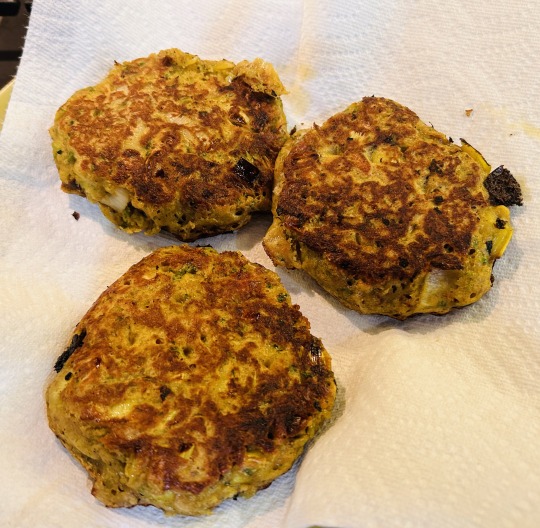
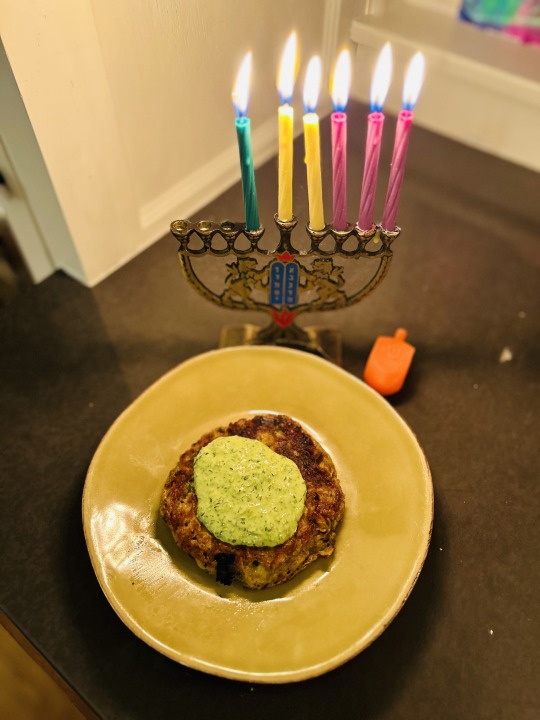
On the sweeter side of things, the Israeli national obsession with Sufganiyot (traditionally jelly and nowadays extremely sinful) is definitely rooted in the diaspora. Almost each Sephardic and Mizrachi community makes its own variation of a sugary fritter using the spices common in their country of origin. In India, for example, Jews celebrate Hanukkah with Gulab Jamun- also a popular street food- that is yogurt based and often flavored with cardamom and rose water.

In Greece, Turkey and the Balkans, Jews made Bimuelos often scented with orange blossom, dipped in honey syrup and fried in olive oil. The Iraqi-Syrian’s Zengoula is closer in texture and shape to an American funnel cake.

Last but certainly not least- is the Sfenj- the ultimate North African competitor to the Ashkenazi Sufganiyot. Similar to its French cousin the beignet, Sfenj is simply pastry dough randomly shaped and coated with powdered sugar. It’s extra delicious when eaten fresh off the frying pan.

Ditch the Deep Fryer for Ricotta Pancakes
If frying is not your thing, rest assured that Hanukkah is also celebrated with dairy. Apparently, the miracle of the everlasting oil in the temple and the bravery of the Maccabees is not the only Hanukkah story. In fact, many Sephardic communities honor the heroic act of Judith - Yehudit. According to the Book of Yehudit and Talmudic tales, Judith lured into her home the Syrian Greek General Holofernes, who was attempting to besiege the city of Bethulia. She offered him salty cheese and wine. Once sedated, she killed him and displayed his corpse at the city gates. Seeing what had been done to their commander- terrified the soldiers, and they fled immediately. The liberation of Bethulia raised morale among the tired Maccabee fighters, and helped bring victory one step closer.

'Judith and Holofernes,' 1605, by Jan de Bray.
The crucial role of cheese in the story of Judith gave reason for certain cultures to celebrate Hanukkah with a variety of dairy dishes. A particularly decadent one is the Ataiyef- the Syrian answer to mundane breakfast pancakes. These are stuffed with ricotta cheese, dipped in rose water syrup, sprinkled with pistachio pieces and deep fried, in honor of Hanukkah of course.
A similar and more attainable recipe is the Roman-Jewish Cassola. This simple gluten-free sweet ricotta pancake is perfect for a weekend breakfast on Hanukkah and throughout the year.
Cassola (adapted from Claudia’s Roden Book of Jewish Food)
-1 lb (500 g) ricotta
-1 cup sugar (recipe calls for 200 gram I reduced to 170, and it was still a little too sweet)
-5 eggs
-2 tbsp oil (I subbed for 1 tbsp butter)
-Grated rind of 1 lemon (optional but adds significantly)
-Blend the ricotta and sugar with the eggs in a food processor.
-Heat oil/ butter in a large ovenproof pan.
-Pour mixture into the pan and cook on medium-low flame until the bottom has set firmly.
-Put under the broiler and let it brown for a couple of minutes.
I served it with cherries and berries and a spoonful of homemade granola. No syrup needed!
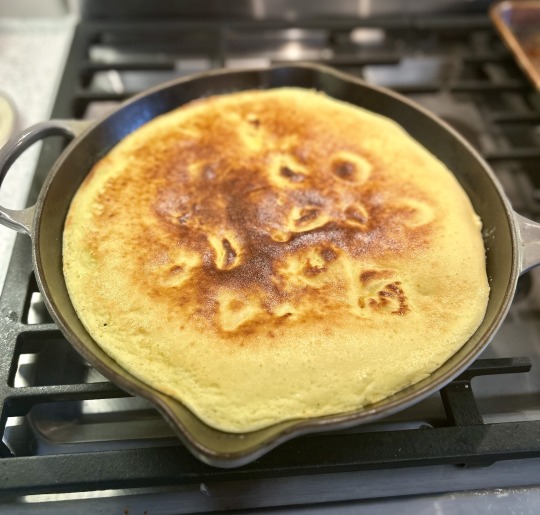

A Women’s Fest
The story of Judith inspired several Jewish communities to add other customs in addition to the dairy feast. In North Africa, the sixth (and sometimes seventh) night of Hanukkah was known as Chag Ha’Banot - (Eid Al Bana', in Judeo-Arabic), or The Festival of Daughters. During this night, women went to synagogue to pray for the health of elderly women in their community, and to ask for a good match for their single daughters. They lit the Menorah recalling remarkable Jewish heroines, such as Judith and many others. The praying sometimes turned into a lively party featuring singing, dancing and drinking wine.
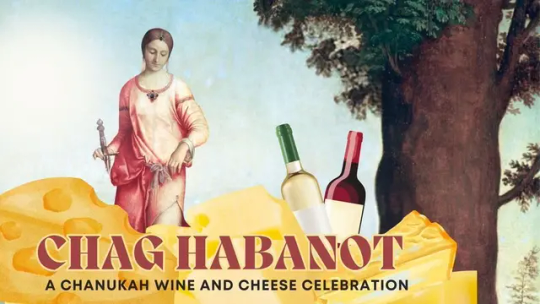
The feast usually included dairy foods, followed by several desserts, such as sweet couscous with chopped nuts and dried fruit.
This ritual is representative of the endless number of mini traditions existing in the Sephardic-Mizrachi world around Hanukkah. To that point, I am sharing one last non-food tradition- the extra candle. Ladino speaking communities and in Aleppo, Syria, had the custom to light an extra candle each night of the holiday in honor of their ancestors, who were exiled during the Spanish expulsion of 1492. A popular song that accompanied the candle lighting was Ocho Kandelikas (8 little lights in Ladino). Enjoy listening!
youtube
#sephardic
#Hanukkah
2 notes
·
View notes
Text
The Cosmopolitan Ghetto - The Story of the Jewish Community in Venice
The idea of a long existing Jewish community in Italy may be surprising to some as the bulk of European Jewry concentrated in the central and eastern parts of the continent. Yet, the Jewish presence in Italy is one of the oldest in Western Europe, and it prevailed for centuries with no interruption until the deportations of World War II. This community of mostly Sephardic Jews stretched all the way from Sicily in the south up to the Alpine regions in the north. Evidence of their rich heritage can be found on signage in the cities, such as Via della Sinagoga, Piazza Giudea and Giudecca.
Although Jews gradually integrated into the broader Italian society, spoke Italian and added pasta dishes and ricotta cakes into their culinary repertoire (more on that later), it would be inaccurate to refer to the Italian community as a homogeneous collective. Given Italy's regional diversity, the peninsula’s map is dotted with numerous small Jewish communities, each of them with its unique history and cooking tradition. Venice is perhaps the most fascinating of all.

The First Ghetto in the World
In the early 16th century an influx of Jews arrived in Venice. The majority of the newcomers were refugees of the Iberian peninsula post Spanish inquisition. Their arrival coincided with an internal migration of Jews from the south (mainly Naples, Sicily and Sardinia) and a flow of escapees from German lands suffering from persecution. This massive immigration and the sanitary crisis it created was the reason behind the segregation of Jews in Venice. In 1516, the Doge of the city issued a decree restricting Jews to reside in a gated quarter that was locked at night. The quarter was called Ghetto after the Jewish pronunciation of the Venetian word for “Foundry” because it was situated near an old foundry that made cannons. The ghetto “invention” was soon replicated in other cities in Italy, and eventually became the generic term, known today for low-income segregated communities.



(above- views from the Ghetto)
In addition to the physical restrictions, the Jews of Venice were also professionally confined to only work as doctors, peddlers, merchants and money lenders. Money lenders, in particular, suffered from a bad reputation as greedy and ruthless. Even Shakespeare in England was aware of that when he portrayed the character of Shylock in the Merchant of Venice. To be recognized, the lenders were forced to wear a yellow star on their coats, and later a red hat, and their appearance fueled the antisemitic narrative of the Jewish villain crushing the innocent Christian man.
However, despite these squalid conditions, the Jewish community of Venice prospered. In fact, Historians suggest that since the ghetto was isolated but not hermetically sealed, it provided the Jewish community the autonomy to develop spiritually and intellectually while simultaneously participating in Venice’s rising commerce.
Inside the ghetto gates, the community life centered around Shabbat and Jewish holidays celebrations. In the Scholes (the Venetian term for synagogue), Rabbinic scholars wrote prolifically about religious and social matters. Several of them traveled outside of Venice to Jewish centers in Europe and near east to spread their wisdom on Talmud and Kabbalah. One of the most well-known figures was Rabbi Simon Luzzato, who served as Venice’s rabbi for 50 years during the 17th century. In his pastime, Luzzato wrote extensively on the relationships between Jews and non-Jews. Another important persona of that time was Rabbi Leon de Modena, known as a rabbinical commentator as well as a music composer. Modena was also a compulsive gambler, and some of his writings addressed his addiction. The poet Sara Coppio Sullam was another intriguing figure. Sullam overcame the gender and racial barriers of her time, and ran a salon that drew educated men from within the ghetto and outside it.
The intense scholastic and artistic blossom in the 17th century was boosted by the printing companies established in the ghetto. These publishers printed hundreds of Jewish and non-Jewish content books and made Venice an intellectual capital in Europe at the time. It became a meeting point for traveling Jewish scholars from across the diaspora, who came from afar to exchange ideas with their valued Venetian counterparts.
Outside the ghetto, Jews took an active part in the city’s maritime commerce. The large scale international merchants - among them a few shipowners- were mostly of Portuguese and Levantine descent. They traded oriental goods, including art, wool, silk, sugar, spices, grain, dried fruit and nuts. Also, Jews were to some degree responsible for the spreading of coffee in the continent. Some historians insist that Venetian Jews were pivotal in the coffee import business and that they consumed it as a stimulant for all-night Torah study.
The accumulating wealth of certain Jews created an interior hierarchy within the ghetto. At the top of the social order were the Ponentini - Sephardic Jews - from the Iberian peninsula and Levantini who came from Turkey, Egypt and Syria. In the middle were the Tedechi - German Jews who migrated to the city early on in the 13th century; and at the bottom were the Italians, who mostly came from southern Italy and Sicily. Each one of these communities had their own communal facilities. Among the four synagogues is the extravagant Scola Levantina, inspired by the highly ornamented baroque style of the time. This structure also attracted the non-Jewish residents of Venice.

(Above- the interior of the Scola Levantina)
Christians - poor and wealthy- came inside the ghetto early morning when the gates were opened. They came generally for business purposes but also to experience the holiday celebrations and street fairs, in particular the bright colored Purim carnival. The Jewish elites in the ghetto with their luxurious garments were also quite the sight. Nighttime funerals, in which a beautiful succession of gondolas were lit up by lanterns, were another well known spectacle. These Jewish- Christian interactions evolved into a symbiotic relationship that manifested itself in the intellectual realm, the arts and of course cuisine. And although each side had its share of reservations about the other, there is no doubt about the significance of this exchange of ideas especially during the golden era of the late 16th to mid 17th centuries.
By the end of the 17th century, when the political and economic power of Venice declined, many Jews, particularly those with means, opted to immigrate either to the Americas or eastwards to the territories of the Ottoman empire in search for new opportunities. Despite the diminishing numbers, the ghetto continued to exist another hundred years until Napoleon’s armies occupied Italy in 1796 and broke its gates in accordance with the principle of emancipation. As equal citizens, the Jews in the city were active in the political realm. Luigi Luzzati, for instance, who led the struggle to better the life of the gondoliers, was elected Italy’s first Jewish prime minister in 1910.
Venetian Jews had a fairly tranquil existence until the promulgation of Mussolini’s racial laws in 1938. When the Germans occupied the city in 1943, 1,200 Jews were living in the city, and 200 of them- including the chief rabbi at the time Adolpho Ottolenghi- were murdered in the death camps.

(above - Ottolenghi’s memorial in the ghetto)
Nowadays, Venice is home to a small Jewish community of 500 people mostly run by the Orthodox chabad center. Only 30 Jews were recently recorded living in the vicinity of the former ghetto. However, the ghetto and its institutions (the 4 synagogues, museum and cemetery) are considered worthwhile tourist attractions.
Where Pasta Meets Chicken Soup- Jewish Venetian Cooking
The cultural interchange between Jews and non-Jews and among the many layers within the Jewish community created a unique and rich Jewish Venetian cuisine.
Inside the ghetto the Levantini introduced the concept of rice pilaf, and particularly rice with raisins. The Iberian Ponentini brought in salt-cod dishes, vegetable frittatas, almondy sweets, orange cakes, flan and chocolate desserts. Both of these groups used a variety of spices (such as saffron), which made their cooking fragrant and excotic especially at a time where condiments were rare and expensive. Sicilian Jews contributed lemons (and lemonade) and pine nuts into the mix. The combo of raisins and pine-nuts became the trademark of the Venetian Jewish cooking, and was served with rice or with fish dishes, such as marinated sardines. The German Tedeschi added heavier meaty ingredients, such as duck sausage and meatloaf with hard boiled egg in the middle. The Ashkenazi knaidlach was refined and became Cugoli- a pasta dough dumpling served with chicken soup. Another example of a multicultural dish created in the ghetto is the Burriche- a savory pastry in between a Portuguese empanada and a Turkish bourekas with Italian fillings, like fish with hard boiled egg or anchovies and capers with fried eggplant.
Because of their foreign origin and their extensive travel as merchants, Jews had an important role in putting new dishes on the Italian table. In fact, some Italian staples, such as almond based sweets or puffed pastry are essentially “Alla Guidia” meaning of Jewish origin. Chrisitians were particularly inspired by the variety of vegetables- including zucchini, cabbage, eggplant, peas, potatoes and spinach- in the “Jewish diet”. Guiseppe Maffioli, the author of La Cucina Veneziana, remarks that the Jews were admired for the sense of imagination in the kitchen, as they mixed together ingredients considered exotic or even forbidden (eggplant, for instance, was initially labeled as the food of the devil) into everyday dishes, such as risotto and pasta.

(above - a Jewish bakery in the ghetto)
On the other hand, Jews were clearly influenced by their Christian neighbors, and their creativity as cooks helped them overcome the limitations of kosher dietary laws. The classic melon and prosciutto antipasto was served with fried eggplant instead of meat in Jewish households. Similarly, pork was substituted with duck or goose because of their fattiness. The hearty and spicy fish stew- is another example of a Jewish speciality emulating a local dish that originally used shellfish. Pasta was eagerly adopted by the Jewish community starting from the 16th century, and many variations of it were created for Jewish festivities. For instance, on wintry Shabbats thin pasta noodles were added to the traditional chicken soup. On Shavuot, it was traditional to make pasta with ricotta cheese and spinach and macaroni with cream and butter. In Purim, Jews prepared sweet pasta with sugar and cinnamon. Risottos were also very popular among Venetian Jews, and were served either with spices (such as saffron) or seasonal vegetables. Unlike typical risotto, Jews often slow cooked the grain instead of stirring constantly. The result is in between a rice porridge and a risotto, a perfect food on a cold Shabbat night.
Riso coi Carciofi- artichoke risotto- embodies the qualities of the Jewish Venetian cooking described above. This particular version was created by the inhabitants of the ghetto who migrated from Sicily, where artichokes were growing wild. This dish is very easy to make especially if using frozen artichoke hearts. Unlike a typical risotto made with beef broth and butter, this variation calls for white wine and vegetable oil, which makes it vegetarian friendly.
Artichoke Risotto - adapted from Claudia Roden’s book, The Book of Jewish Food
2 ¼ cups water
2 ¼ cups dry white wine
8 tbsp sunflower or vegetable oil
1 ¼ cups italian risotto rice (Arborio)
Salt and pepper
14 oz (400 gram) artichoke hearts defrosted
1.Bring water and wine to boil in a medium size small pan.
2.Simultaneously, in a frying pan, heat 4 tbsp of oil, add the rice and stir until it is coated and translucent.
3.Pour the rice into the wine and water, add salt (½ teaspoon) and peeper, cover and simmer for 20 minutes or until the rice is tender but firm, and there is a little liquid.
4. While the rice is cooking, heat 4 tbsp of oil in the frying pan and add the artichoke hearts and some salt. Keep stirring until the hearts are slightly brown.
5.Once the risotto is cooked add the artichoke with a slotted spoon at the top.



Enjoy as is or add freshly grated parmesan for additional flavor (highly recommended).
The Only Daughter- Jewish Venice in the Eyes of the Literature
The literature piece chosen for this post takes the reader far away from the lively renaissance days into the gloomy existence of the Jewish community in Venice today. The book The Only Daughter by A.B. Yehoshua is a portrait of a shrinking, dying, highly assimilated community with no prospect of renewal.
Rachele Luzzato, the heroine of the story, is the only child of a well-to do Jewish lawyer and a converted Italian mother. Although raised Jewish, Rachele is attached to her catholic maternal grandparents, and drawn to their religious traditions. In fact, one of the threads in the book is Rachele’s disappointment when her father forbids her to participate in the school’s nativity play. Rachele adores her father, and they have a sweet close relationship. Sadly though the father is dying from a brain tumor, and his impending death is clearly a metaphor to the state of the Venetian (and overall Italian) contemporary Jewry. This leitmotif of decline also appears in the side story of the Jewish tutor. As Rachele reaches the Bat Mitzvah age, she and her friend are taking Judaic lessons given by an orthodox rabbi from Israel. The rabbi is single and he arrives in Venice on a mission to find a proper match. Yet, much to his dismay, there is no inventory! Accepting the circumstances, the rabbi loosens up and participates in the carnival party organized by Rachele’s Jewish grandmother. Ironically he disguised himself as a priest. Being so convincing in his catholic appearance, the guests in the party approached him as “father”.
A.B. Yehoshua, one of Israel's top living authors undoubtedly blends in his political agenda in this tender tale about a Jewish adolescent. Yehoshua is a vocal speaker about the diminishing diaspora, and his arguments against assimilation and the urge to strengthen the bond with Israel cause a great controversy in the Jewish world.


(above- A.B. Yehoshua and myself)
In the case of The Only Daughter the choice of Venice for location is not coincidental and speaks of the imminent crisis. The concept of a city with a glorious past physically sinking down alongside a history of heavy plagues (including the black death in the medieval and several cholera outbreaks between 1817-1923) inspired many writers to choose Venice as setting for stories about decay, notably Thomas Mann’s novella Death in Venice (one of my absolute favorites).
Regardless of your views on the matter, reading the Only Daughter is highly recommended. It is beautifully written and masterfully conveys the mysterious charm of Venice.
11 notes
·
View notes
Text
Mediterranean Medley: The Jewish Community of Tunisia
Tunisia is currently making global headlines. A decade ago the Tunisian protest for democracy sparked the “Arab Spring”, which led to vast political shifts in the Middle East. Now, its citizens are fighting to retain their past achievements and curb the ruler's authoritarian pursuits.
The recent events in this small country on the southern shore of the Mediterranean also provide an opportunity to discuss its Jewish community, a community small in numbers yet incredibly diverse in terms of socio-economic status and cultural orientation. This entry is therefore dedicated to exploring the complex history of the community, including the particularly tragic chapter of the Nazi occupation during the Second World War. As always fiction and culinary elements will be weaved into the discussion.
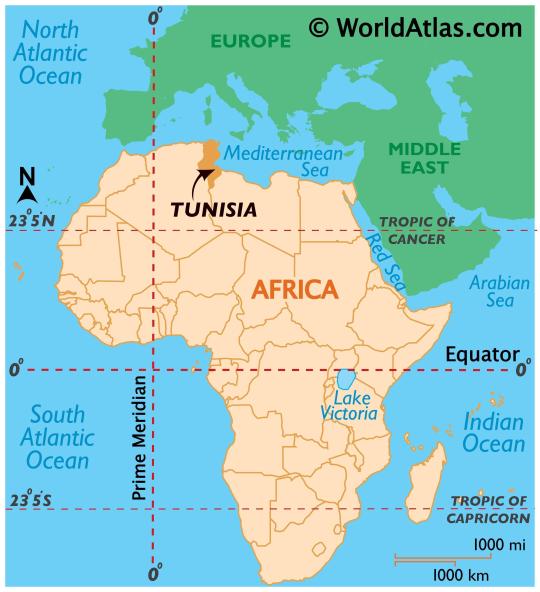
(Tunisia on the map: between Africa and Europe)
Berber, Italian and French Mix
The Jewish community of Tunisia settled mostly in the coastal areas in the cities of Tunis, Sousse, Sfax, Bizerte and Monastir. There were also several rural Berber communities, in which Jews lived a semi-nomadic life.

(The beautiful coast)
The origin of the Jewish community is disputable. Members of the community claim the first settlers migrated from Jerusalem after the destruction of the second temple in 70 CE. Several scholars, however, ascertain that the community originated from the conversion of either Phoenicians or Berber tribes.
Origin aside, archeologists indicate a viable Jewish presence beginning in the fourth century CE. Evidence also shows connection between Tunisian Jews and Jewries in Persia, Israel and Iraq. The Bagdadi community and its Talmudic centers, in particular, was a source of inspiration fueling the local Torah learning, and overall intellectual life.
In the fifteenth century, Andalusian Jews found refuge in Tunisia while escaping the Spanish Inquisition. Their influence is notable in architecture, culture, and clearly cuisine. Another wave of Jewish immigrants arrived to Tunisia from the Italian port city Livorno during the sixteenth and seventeenth centuries. The Livornese Jews, mostly Portuguse Marrano descendants, built maritime trade between North African hubs to European Mediterranean port cities. In 1741, the Livornese community (also called “Grana”) asked for autonomy on the pretext of having a different liturgy. Followed by this act, two separate communities- native and Livornese- were formed. The two sub-communities had their own rabbis, synagogues, cemeteries and philanthropies. The Livornese section, which actually encompassed all European Jews whether they came from Italy, France, Gibraltar or Malta- prided themselves as superior. They refrained from intermarrige with the native Jews, refused to speak Judeo-Spanish and continued speaking Italian. Some of the Livornese became rich bankers and merchants, but many were weavers, tailors, shoemakers, and even lived in poverty relying on charities.
In the cities, since Medieval times, the indegenous Tunisian Jews, lived in the margins of the Muslim areas and the Souks, in quaters named Haras. The Haras became overpopulated starting in the second half of the nineteenth century with poor sanitary conditions, and no running water nor electricity. The residents of the Hara were mostly craftsmen- tailors, potters, leatherworkers and silversmiths. Those who could afford it, left the Hara to settle in the European quarters built by the French.
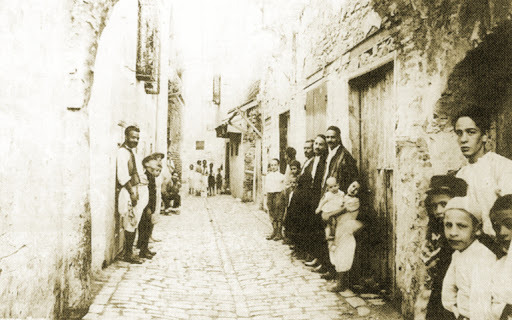
(The Hara of Tunis, image #1)
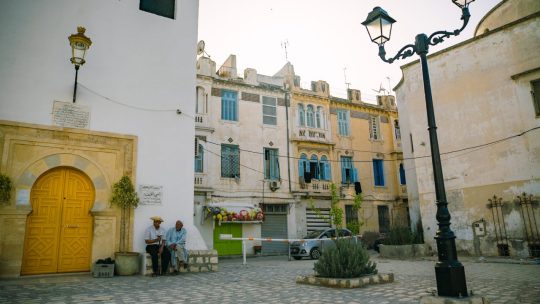
(The Hara of Tunis, image #2)
The French Colonization, starting in the late nineteenth century, created a new elite of Francophones. The upper Jewish class eagerly fostered French as their mother tongue, named their children in French names and sent their children to schools in Paris. The few, who managed to obtain key posts in the new colonial governments, were granted French citizenship, but the majority including some of the wealthiest families remained with the status of subjects.
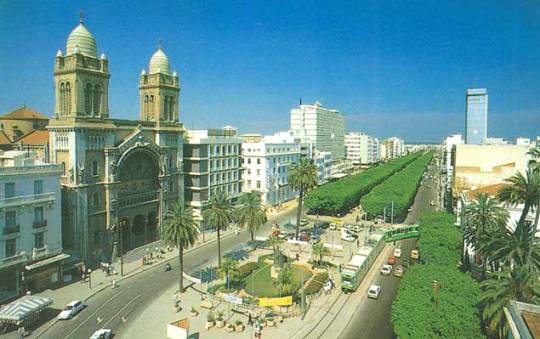
(The French Quarter of Tunis)
Despite the strong French influence, Tunisia continued to be fairly diverse as a port country luring people from different parts of the Mediterranean basin. Thus, the Jewish population (unlike their brothers in neighboring Algeria) lived in a multicultural environment, in which Greeks, Maltese, Italians and of course Arabs co-existed and influenced one another.
A Boy in a Ruthless City: The Nazi Occupation through the Eyes of an Adolecent
The cosmopolitan climate described above was the setting of Albert Memmi’s (1920-2020) semi-autobiographical novel, The Pillar of Salt. In the book, Memmi, a distinguished philosopher known for his work on Colonial Studies, disguised himself as Alexandre Mordekhai Bennillouche, a poor Jewish boy growing up in the Hara of the capital, Tunis.

( Albert Memmi)
Bennillouche (or Memmi) begins his account in describing his happy childhood as an age of innocence and unawareness to his poverty and inferior status as a “native Jew”. Gradually, the protagonist discovers the world around him. He excels at school, but suffers from anti-Jewish violence from Chirsitan and Muslim peers. Given his academic performance, he is given a stipend to study in one of the city’s top schools, where he is introduced to the upper circles of the Jewish community and the general European society. This exposure causes a rift in the relationship with his parents, who resent his education wishing for him to continue the family leather business. Although deeply ashamed of his parents - their meager existence and traditional views- Bennillouche is quickly disillusioned from the enchantment of the elite. Being a critical thinker, he spots its insincerity and snobbery, yet he is forced to hide his contempt as he is dependent on their funds for his schooling.

(The capital- Tunis)
The six month Nazi occupation of Tunisia (November 1942- May 1943) reaffirms Bennillouche’s beliefs about the hypocrisy of the elite. During the short- yet traumatic - German presence, Tunisian Jews were subject to constant harassment from the occupiers and general population, and were under the imminent threat of being deported to the death camps in Europe. Yet, the degree of Jewish misery varied based on socio-economic belonging. When the Germans issued a decree for Jewish forced labor, the wealthy ones of the community paid ransom to exempt themselves and their dear ones. Impoverished men- however- were destined to greater hardship.
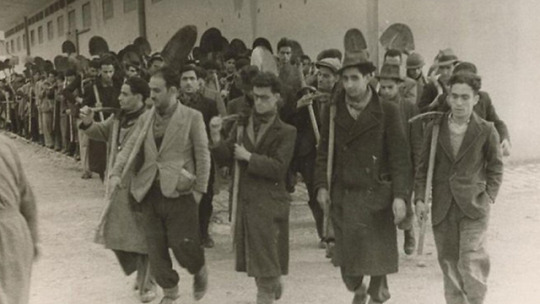
(Jews assigned for forced labor)
Benillouche (and Memmi himself) was one of the unfortunate people. Despite being friendly with people in high places, and holding a prestigious teaching position, he was deported to a concentration camp in the Saharan desert. There, he suffered from the brutality of the guards, the senseless work, and above all the merciless sun. However, camp was also a place of revelation. The hardship created a sense of comradery between Benillouche and his fellow inmates, of whom he shared similar upbringing. He was even reunited with some old friends, and enjoyed conversing with them in his childhood dialect of Judeo- Arabic, which he neglected in favor of French. In addition, the camp helped him to rediscover and reconnect to his Jewish roots, as he was asked to lead Shabbat prayers as the camp’s intellectual figure.
By the time the camp was released by the Allies, Bennilouche was a more grounded man. He still continued to march according to his original trajectory in the academic world but with a wiser outlook on life.
Topped with Harissa: A Quick Peek to Jewish-Tunisian Cuisine
Even while estranged from his family traditions, Bennilouche always maintained a fondness for his mom’s traditional Tunisian cooking. In fact, he recounts nostalgically the smells of Shabbat dishes cooking slowly in the tiny kitchen of his childhood home. When he matures, he recognizes the power of food as a source of comfort and festivity in a household that is poor and filthy. One of the dishes he highlights is Bkeila (also pronounced Pkeila) - a hearty spinach and beans stew served vegetarian or with beef. Below is Yotam Ottolenghi’s take on it from his latest cookbook Flavor.
Bkeila, Potato and Butter bean Stew - Adapted from Flavor
(See my notes below to simplify the cooking process)
4 cups (80 gram), roughly chopped cilantro
1 ½ cups (30 gram) parsley
14 cups (600 gram) spinach
½ cup (120 ml) olive oil
1 onion (150 gram), finely chopped
5 garlic cloves, crushed
2 green chiles, finely chopped and seeded
1 tbsp plus 1 tsp ground cumin
1 tbsp ground coriander
¾ tsp ground cinnamon
1 ½ tsp superfine sugar
2 lemons: juice to get 2 tbsp and cut the remainder into wedges
1 qt/ 1L vegetable/ chicken stock
Table salt
1 Ib 2 oz/ 500 gram waxy potatoes, peeled and cut into 1 ¼ inch pieces
1 Ib 9 oz/ 700 gram jar or can of butter beans, drained
1.In batches, put cilantro, parsley and spinach in a food processor until finely chopped. Set aside.

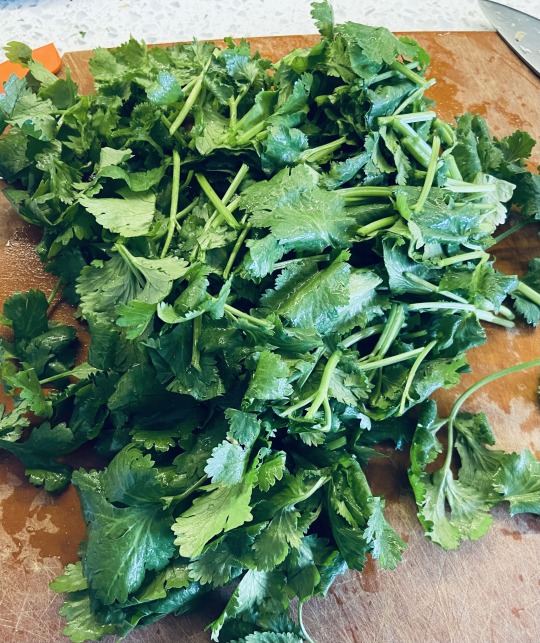
(Massive amounts of greens)
2.Put 5 tbsp of olive oil into a large heavy-bottomed pot on medium heat. Add the onion and fry until soft and golden, mixing occasionally (about 8 minutes). Add garlic, chillies and all the spices and cook for another 6 minutes, stirring often.
3.Increase the heat to high and add the chopped herbs and spinach to the pot along with the remaining 3 tbsp olive oil. Cook for 10 minutes, stirring occasionally until the spinach turns a dark green. The spinach should turn a little fried brown but not burn. Stir in the sugar, lemon juice, stalk and 2 tsp salt. Scrape the bottom of the pot if needed. Bring to a simmer, then decrease heat to medium and add the potatoes. Cook until they are soft for about 20-25 minutes and then add the butter beans and cook 5 minutes longer.*
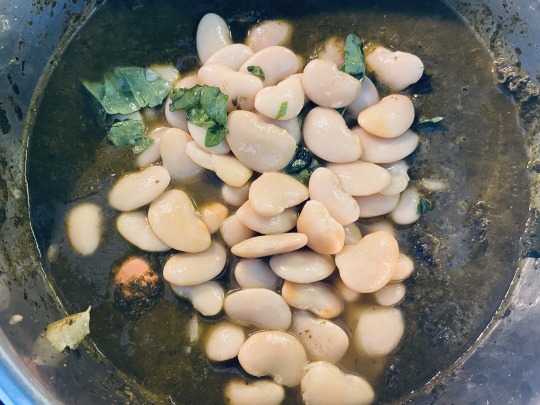
(Butter beans to break the deep green)
4.Divide into bowls and serve with lemon wedges.**
* As this dish was traditionally slow cooked using a slow cooker pot or a pressure cooker could easily do the trick. If using these- do the following: Skip step 1. Saute the onions, garlic, chilli and species as instructed in step 2. Then add the rinsed spinach and herbs. Mix them well with the onions and spices in the bottom. Once the spinach begins to melt, mash them using a hand blender and then add the ingredients described in step 3 (beside the butter beans). Then let it slowly cook until everything softens. In the end, add the butter beans and press on the “stay warm” button.
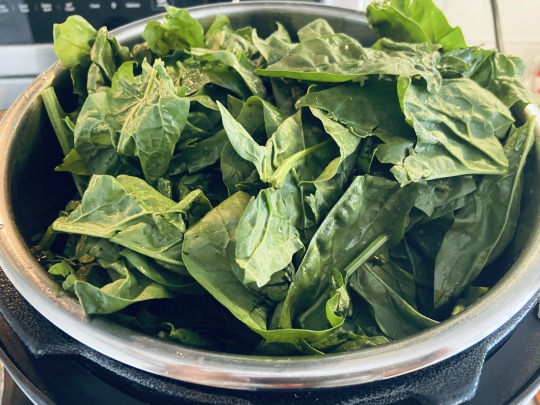
(loading the pot with spinach)
** I served it with bulgur to soak up the liquids a bit (rice, farro or any other grain will work as well). I also added hard boiled eggs for additional protein.

(Healthy and heart)
In addition to the Bkeila- The Tunisian Shabbat table will not be complete without the famous couscous. The process of making it from scratch without a food processor was quite laborious, but the result - whether served sweet with nuts and spices, or savory with meat stew or fish - was considered a delicacy.
The proximity to the Mediterranean shore brought fish dishes to the Jewish- Tunisian repertoire. Fish is mostly eaten fried or cooked as fish balls or oven roasted served with red hot sauce. Meat is also often served spicy, and often chunks of hot merguez sausage are added to stews or shakshuka.
Generally speaking, Tunisian Jews are fond of hot flavors, and their cuisine is potentially the spiciest in the diaspora (perhaps only second to the Yemeni). Harissa paste, now increasingly popular around the world - is liberally used to spice up any dish. This fiery red pepper condiment is added - for example- to the famous Tunisian fricassee, one of Israel's most popular street foods. Click here for a recipe for this tuna loaded sandwich, and here to learn more broadly about Tunisian cuisine.
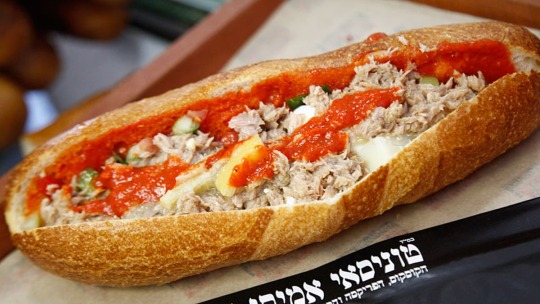
(Tunisian Sandwich with some Harissa)
8 notes
·
View notes
Text
Beyond the Purim Story: An Introduction to Persian Jewry
Centered in the ancient capital of the Perisan Empire, the story of Purim offers a glimpse into the life of the Iranian jewry- a long standing community with roots beginning in biblical times to Contemporary Iran. In the Megillah, the orphan Esther, paves her way into the royal court, and later saves her Jewish people from destruction. Although historically questionable, the Purim tale in many ways, is a microcosmos of the history of the Iranian community. A saga that could be sketched as a linear graph with sharp ups and downs, from regality to poverty, from great political power to persecution. And to add to this extraordinary trajectory, It is also one of the few Jewish communities still existing (rather miraculously) in large numbers in a Muslim country, and under radical theocratic regime.

A portrait of Queen Esther
Despite this fascinating history and the important contribution of Iraninan Jews to global commerce (which will be discussed later), the topic received very limited scholarly attention. In fact, less than a handful of books were dedicated to Persian Jewry. I lament this on a personal level as I am Iranian from my paternal side. Therefore, this post is a humble attempt for reparation. It contains a short historical view, and aims to provide a sense of its rich folklore through the lens of fictional literature and culinary.
Major Milestones in the History of Persian Jews
The Persian community is one of the oldest ones in the diaspora as it dates back to the Babylonian exile in the fourth century B.C. For the two centuries to follow, the Perisan community was linked to the Jewish communities in Babylonia and Mesopotamia. The famous Yeshivot (Torah learning academies) in Sura and Pumbedita, in which the Babylonian Talmud was crafted, were a source of guidance for the refugees in Persia. To this day, the Iraqi and the Persian communities bear much resemblance in terms of culture and religious practice. Their cooking (later discussed) is similar as well.
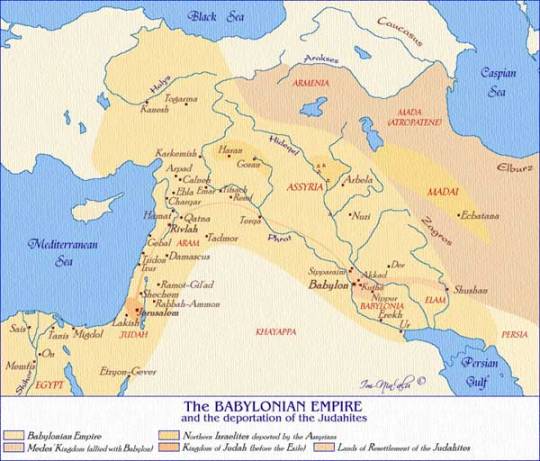
Babylonian Exile map
In ancient and medieval times, the Jews of Persia were well known as savvy and wealthy merchants. Situated in a prime location between China and India and Europe, Persian Jews were pivotal in what was then global commerce. Through the Silk Road and other networks of trades, Persian Jews imported spices and other goods, such as rice and tea to the west.

Silk Road’s Routs
Persian Jews were influential and properous through the first generations following the Arab Muslim conquest of Iran in the third centry A.D. Their status and living conditions deteriorated significantly with the accession of the intolerant Shiite Safavid rule. Under a regime, in which non- Muslims were considered impure heretics, Persian Jews were pushed to the margins of society and poverty. Excluding a short resurgence during the Sunni Mogul takeover of Persia in the sixteenth century, the Persian community lived under hardship and fear. The Shiite Shahs harshly oppressed minorities, denying them any position of power and restricting them to a few professions and areas of living. In several episodes in the course of the seventeenth, eighteenth and nineteenth centuries, Jews were expelled from the cities they lived in and forced to convert to Islam. Subsequently, many Persian Jews fled to Iraq, Syria, Samarkand and Georgia.
The economic and overall living situation improved in the late nineteenth century as Iran increasingly opened to the west. Although still segregated in Jewish quarters, urban Jews pursued western education. Jews, including women, gained proficiency in languages, such as English and French. They also increased their integration into local Iranian society, and named their children in both Hebrew and Parsi names. Jewish women did not veil, but they adopted the black Chador to cover their faces when out of the house. Similar to other Jewish communities at the time, girls were betrothed at age 8 or 9 and married when they were about 16. It was common for women to pilgrim to other parts of the country to visit sites, such as Queen Esther’s burial place, near Isfahan.

Queen Esther’s Tomb
The rise of the Pahlavi dynasty in 1925 marked a turning point. This transformation allowed the Jews once more to be in a position of influence both politically and economically. Many immigrated from the hinterland to Teharn to explore new opportunities, and a few became close to Risa Shah and other men in powerful posts. For the most part, this elite chose to stay in Iran after Israel’s Independence. The lower and middle class Jews opted to immigrate to the new Jewish State in 1948.
The Muslim revolution in 1979 drew a sharp decline in the status and overall safety of Iranian Jews. After decades of prosperity, the Jewish community was once again isolated and in grave danger. The initial period of the new Isalimic republic was particularly traumatic given constant harassment and even execution of several Jewish businessmen for their alleged connection to Israel and the United States. In the following years, the situation seemed to stabilize, and Jews were given a certain degree of religious autonomy. Although most Iranian Jews fled the country in several waves in the aftermath of the revolution, a sizable group remained. Today, their number is estimated at nine thousand. Given the lack of reliable information, their overall condition is unclear. Recent imgirants paint an ambiguous image of harmony with Muslim neighbors, and yet a feeling of imminent threat. Unsurprisingly, Iranian news reports emphasize the community’s well being and alignment with the regime.


Images of contemporary community life
Outside of Iran, Israel and North America are the main hubs of Iranian Jewry and smaller pockets exist in London, Melbourne and Buenos Aires. Two significant communities in the United States are located in Great Neck, New York (also known as Persian Island) and in Los Angeles (it’s estimated that about 25 percent of Beverly Hills population is of an Iranian- Jewish descent). Many of the immigrants in America were able to bring their fortune to the new land and used their capital and expertise to start businesses in the clothing, food and electricity industries.
In Israel, as an attempt to integrate, Iranian Jews adapted to the culture and values of mainstream society while leaving their own heritage behind. This may be a gross generalization, but sociological studies, statistics and experience of living in Israel suggest a trend of assimilation. As a result of their pragmatism, Iranian Jews have made great accomplishments in the sphere of public service. The IDF, in particular, was a stepping stone to obtain power within the military (and later in Israeli politics). Among its current and former ranks, one can find a high number of generals of Iranian descent, including two chiefs of staff.
Real Persian Housewives
An exception to the unspoken policy of concealing Persian legacy is the author Dorit Rabinyan. Born in Israel into a warm tight knit Iranian family, Rabinyan used her gift for writing to bring Persian tradition into the spotlight. Inspired by her grandmothers and aunts’ tales of life in the old country, Rabinyan published her first novel Persian Brides (titled in Hebrew, The Almond Tree Road in Oumrijan) when she was only 21 years old. The book, an immediate bestseller, was widely translated and praised by critics, describing Rabinyan as a meteor and comparing her to Gabriel García Márquez”.
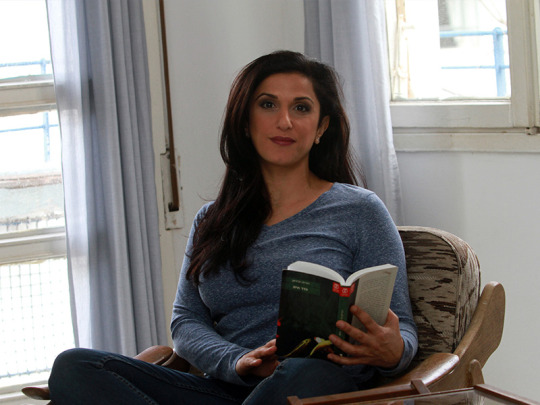
Dorit Rabinyan
In Persian Brides, Rabinyan masterfully crafted a new hybrid of Hebrew- rich and whimsical -Parsi sounding text. Through her vivid language, Rabinyan invites the reader to experience the surreal Persian village of Oumrijan in the dawn of the twentieth century. The plot centers around two maidens, Flora and Nazie Retoryan, and their dramas involving marriages, pregnancies and relationships with their neighbors and the village demons.
Since marriage is a central thread in the book, there are many descriptions of ceremonies and superstitions involving the bride to be. One of them, hilarious and sad at the same time, is the qualification test performed the day before the wedding. This is a test run by the mother of the groom in order to assess if the future daughter in law will qualify as a housewife. So what makes a good Persian housewife? The answer is superior herb chopping skills... perhaps understandable given the amount of vegetables used in Persian cooking (see section below). During the test, the poor girl needs to demonstrate how quickly and meticulously she handles a massive amount of greens needed for Khoresht Sabzi- a traditional stew. The pressure around the “Sabzi test” was so daunting that bleeding injuries, including losing fingers, were common. Here is the excerpt from the book:
“The bride had to prove her skills in cleaning and chopping the Sabzi, the herbs that Janjan sold in the market...the women of the village and relatives circled the bride...On a silver tray, they put bunches of celery, traggon, sage, rosemary, mint, spring onions and parsley. Homma (the bride) was sitting on the ground with her legs crossed as the Sabzi stems hill reached all the way up to her breast… Homma began quickly by separating the leaves and the roots from the celery, the spring onion stems from its onion, the sage from its delicious smelling flower buds, all of these were soaked in a big water bowl. later, the mint, tarragon and parsley leaves were washed as well...Homma reached for the sharp knife. Its blade was shining, and the women were shushing each other. Nazie knew that the tested brides sometimes get injured because of the pressure, and sometimes they even cut off their fingers. When that happens they deposit the cut finger with their mother, and continue to chop while they are heavily bleeding. But if not a single blood drop spilled during the test, and the herbs were finely chopped, the women sang and danced in circles around the bride as she was proven to be a skillful and well trained cook at her parents’ kitchen”.
Khoresht Sabzi Recipe
In honor of poor Persian housewives, I am including here a recipe of Khoresht Sabzi. This is a more user friendly version of this staple dish as it allows using dried herbs (although I highly recommend fresh for flavor), and it calls for a smaller variety of herbs. Note though that other available herbs (for example, dill, traggon, basil) will be a wonderful addition to the herbs listed below. In addition, middle eastern grocers sell pre cut Sabzi mixes (either dried or frozen), which can make the process even easier. Lastly, I listed lamb as one of the ingredients, but variations are welcome. In my family, Khoresht Sabzi was served with chicken, but it is also fabulous as a vegan dish (see modification below) as I prepare it.
Khoresht Sabzi- Adapted from Najmieh Batmanglij’s book Food of Life: Ancient Persian and Modern Iranian Cooking and Ceremonies.
6 tbsp oil, butter or ghee
2 large onions thinly sliced
2 pounds lamb shank (optional)
2 tsp salt
1 tsp ground pepper
1 tsp turmeric
½ cup drained kidney beans - either canned or soaked overnight (increase the amount to 1 cup if omitting meat)
2 whole limu- omani - dried persian limes pierced
4 cups finely chopped fresh parsley or 1 cup dried
1 cup finely chopped fresh chives or scallions or ¼ cup dried chives
1 cup finely chopped fresh cilantro
3 tbsp dried fenugreek leaves or 1 cup chopped fresh fenugreek
¼ cup lime juice
1 tsp ground cardamom
½ tsp of saffron threads dissolved in
2 tbsp of rose water (or hot water)

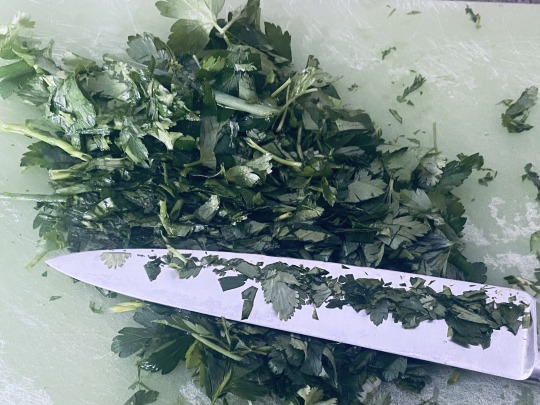
Let the chopping begin
1. In a large saucepan (preferably a dutch oven), heat 3 tbsp oil over medium heat, and browned the onions and meat (if using). Add salt, pepper and turmeric, and sauté for 1 minute.
2.Pour 4½ cups of water, and add the kidney beans and dried limes. Bring to a boil, cover and simmer for 30 minutes stirring occasionally.
3.Meanwhile, in a wide skillet, heat 3 tbsp oil over medium heat, and sauté the parsley, chives, cilantro and fenugreek for about 20-25 minutes stirring frequently to avoid the burning of the herbs.
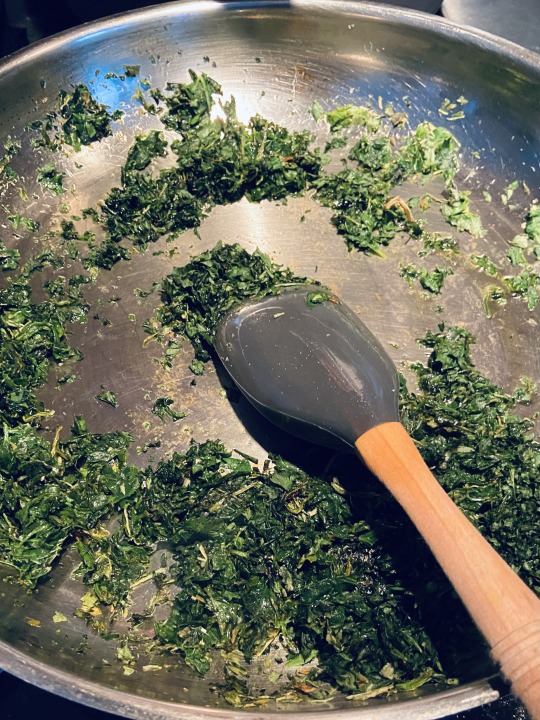
shrinking herbs
4. Add the herbs mixture, lime juice, cardamom, and saffron with its water to the large saucepan. Cover and let simmer for 2 -2 ½ hours, stirring occasionally.

Simmering slowly
5. Check if meat and beans are tenders and add salt if needed.
6. Serve warm on a bed of steamed basmati rice.

Gratifying bowl on a cold winer night
Festive, Aromatic and Nutritious: A General Note on Persian (and Jewish) cuisine
Khoresht Sabzi - quintessential among Jews and their Muslim neighbors- can shed light on the Iranian kitchen as a whole and its link to Persian folklore. The Israeli celebrity chef, Yotam Ottolenghi wrote on this topic, in his book Plenty More:
“My Previous life must have been somewhere in old Persia. I am absolutely convinced of this. I am completely infatuated with the richness of Persian cuisine, by its clever use of spices and herbs, by the inguianty of its rice making, by pomegranate, saffron, and pistachios, by yogurt, mint, and dried limes. It seems that my palate is just naturally honed for this set of flavors”.
Ottolenghi’s words well capture the exotic and diverse essense of Persian cuisine. Specifically, the culinary practices of contrasting dominant flavors (obtained by adding sour taste, such as pomegranate or lime juice to savory dishes), and textures (for instance, the combination of dried fruit and herbs) are indeed extraordinary. The slow cooking of a wide array of fruit (such as pears, apricots, dates and cherries), nuts (pistachios, almond and walnut) and spices (saffron, cinnamon and turmeric) also add a layer of complexity and colorfulness.
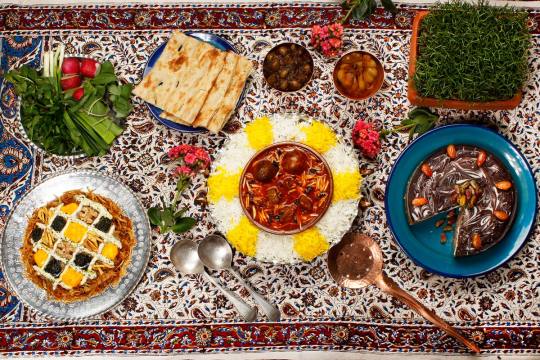
Typical Persian assortment
The Zoroastrian concept of duality between good and bad, light and darkness -embedded in Iranian culture- was a key factor in the development of Persian cuisine. It inspired the aforementioned balance between sweet and sour, hot and cold, lean and fatty that exists in many dishes. Concerned with health, and mainly digestion, Persian cooking offers a dichotomy between hot foods, which thicken the blood and increase the metabolism, and cold foods that do the opposite. Dates and grapes are, for instance, “hot”, while plum and oranges are “cold”. A diet consisting only of one type of food can essentially imbalance the body and lead to an illness. Accordingly, the high consumption of herbs and green vegetables in almost every meal also stems from the concern regarding nutritional properties adjuncting food and medicine.
Iran’s historic role in importing goods from the far east and its interactions with its neighboring regions also shaped the culinary culture. Particularly, the Mogul - indian conquest and the long Ottoman reign increased the selection of spices, and introduced dishes, such as baklava and yogurt to the Iranian repertoire. These interchanges also spread Iranian staple dishes to other parts of Central Asia and the Middle east. Sephardic communities in these areas, particularly in Iraq and Turkey, adopted the Persian combination of fruit with meat, and rice with legumes.
Rice is perhaps the most iconic Iranian staple. It is made with a sense of perfection aiming to avoid porridge-like texture. Rice is commonly prepared either as Choleh - steamed with saffron scent and a crunchy crust (Tahdig) or as pilaf - mixed with vegetable, fruit and beans. A very colorful pilaf is the Wedding rice served with almonds and dried fruit.

The Art of Tahdig
Hearty stews, known as Khoreshts (such as the aforementioned Khoresht Sabzi) frequently accompany the rice. Khoreshts are vegetable and herb based but utilize local ingredients unique to specific regions of the country (caviar in the Caspian sea area, for example). Another important dish is Kuku- a savory bake that can be compared to crustless quiche (or an Israeli Pashtida). Popular Kuku are made out of herbs, eggplant (also known as Iraninan potato) and my favorite cauliflower. At the end of the meal, Iranians enjoy a cup of tea served with a sugar cube and a nut based treat, such as nougat or walnut cookies.

Kuku: Colorful and heathy
Persian-Jewish cuisine is basically identical to the majority cuisine with one main distinction. Due to Kosher dietary laws that separate meat and dairy, Jews refrained from using Ghee (clarified butter) and yogurt in meat stews. Iranian Jews contributed a very popular dish to the Iranian collection - Gondy chickpeas dumplings that are traditionally cooked in chicken broth.

Gondy: The Persian answer to Matzah Balls
6 notes
·
View notes
Text
The Sephardic Communities in Jerusalem - The Invisible Walls of the City
Diaspora is defined as the dispersion of the Jews beyond Israel or as Jews living outside Israel. Accordingly, this blog has thus far explored the life of Sephardic communities in various countries in the Mediterranean Basin and in the Middle East. This post, however, is a special one as it is dedicated to a group of Sephardic communities that have been residing in Israel for over 500 years. These Sephardic communities left their diasporic homes towards the ancient homeland starting in the 16th century, but still to this day operate within their old and somewhat isolated diasporic mode of speaking their own dialect, resolving conflicts in community structures, and marrying among themselves. As the holy capital, the city of Jerusalem became a hub for those types of Sephardic communities, and for that reason, it is the focus of this blog post.

A Peculiar City
As a sacred place for the three monotheistic religions, Jerusalem attracts people from a wide array of origins to settle in it. A short walk in the city streets reveals how incredibly diverse and complex it is. Every neighborhood encompasses a different world of language, culture, and worship. Sometimes within a distance of a few houses, the scenery changes dramatically: Arabic replaces Hebrew or Yiddish and affluent residences transform into low-income housing. It is not a rare sight, for instance, to witness an old Palestinian shepherd letting his sheep graze in the front lawn of an urban neighborhood. Being so hard to define or explain, no wonder that the late Amos Oz, one of Israel’s most renowned authors, called the city “one of the most peculiar places on earth.”
Unfortunately, as well reflected in global news, the relationships between the various ethnic and religious groups in the city are far from being harmonious. Clashes minor or major occur daily, fueling the already heated climate. The late Israeli poet Yehuda Amichai, a longtime resident of Jerusalem, repeatedly lamented about the friction in his poems. Below is a passage from his poem “Jerusalem,” which beautifully captures the city’s animosity:
On a roof in the Old City
Laundry hanging in the late afternoon sunlight:
The white sheet of a woman who is my enemy,
The towel of a man who is my enemy,
To wipe off the sweat of his brow.

(Above- the different communities in the Old City)
Even within the Jewish context, there are invisible walls dividing the numerous religious sects and various ethnic groups, which exist beyond the obvious separation from the ultra-orthodox sector. The Sephardic community, as previously mentioned, is an umbrella name for multiple groups that are separated from each other linguistically and culturally, as they originated from various parts of the world, such as Uzbekistan, Bulgaria, Yemen, Iran, and more. Although these communities have maintained friendly relationships on the surface, there is a strong sense of segregation between the communities, each keeping its gates closed for outsiders. Even the formation of the State of Israel that unified everyone under the idea of one nation could not dissolve these firm barriers.
This post will look into these communities and specifically showcase two distinct groups: the Ladino speaking community and the Bucharian (Uzbek) neighborhood, through art and culinary.
Ladino Speaking Communities: Jewish, Latin, and Balkan Mixed Together
The 16th century marked major shifts in Jewish demography. In the wake of the expulsion from Spain (1492) and the forced conversion in Portugal (1497), Jews wandered eastwards around the Mediterranean basin. About 200,000 Jews found refuge in the Muslim-ruled Ottoman Empire, which at the time, extended from the Balkan regions of Europe to the vast lands of the Fertile Crescent. As a result, cities, which had little-to-no Jewish population, such as Constantinople and Salonika, became significant centers both demographically and spiritually.
A sizable group of deportees also arrived to the land of Israel, then a province in the Ottoman Empire, and settled mostly in Jerusalem. Since the expulsion created an acute theological crisis, many sought resort in apocalyptic beliefs. Jerusalem was, therefore, the ultimate destination for those who connected their plight with the arrival of the Messiah.
In addition, to those who came directly to Jerusalem, a constant flow of Jews migrated towards Jerusalem from the Balkans and present day Turkey throughout the late 15th and 16th centuries. Therefore, by the mid-16th century, the number of Jews in the city doubled. New Sephardic synagogues were established inside the walls of the Old City, and these attracted well-known rabbis and scholars, such as Rabbi Ovadia Bertenura and Rabbi Solomon Sirili.
Little by little, the immigrants from Spain and the Ottoman Empire evolved into a community known as the Old Sephardic community in Jerusalem. This community prided itself for being Sephardim Tehorim–Pure Sephardic– direct descendants of the glorious community from Spain, which generated some of the greatest Jewish philosophers and poets. Being extremely connected to their heritage, the community zealously maintained the religious practices and language called Ladino, a blend of medieval Spanish with some Turkish and Arab words, written in Hebrew script.

(Above- a Sephardic family in the mid 19th century)
The Ladino speaking community, also known as the Spanyolitim, saw itself as the elite of the Jewish society in Israel. They negotiated with the Ottoman officials and the Muslim populaition in the country. Many of them were merchants, who traveled to other cities in the Ottoman empire - mainly Beirut and Damascus- to import goods. Given their socio-economic status and their attempt to keep their lineage unmixed, the Spanyolitim refrain from marrying outside their community. Marital relationship with the Ashkenazi community was banned, and even engaging with other groups within the Sephardic community (such as the Mograbim,the North African Sephardim) was unacceptable. Wedding celebrations, as well as other communal gatherings, took place in the four Sephardic synagogues in the Old City.

(Above- Yochanan Ben Zakai Sephardic synagogue in 1927)
The thread of keeping a tight and pure community is in the center of the novel the Beauty Queen of Jerusalem by Sarit Yishai Levi. The story takes place in the late 19th century and early 20th century and it centers the Armosa family - an archetypical old Sephardic family: well to do with a prominent ancestry. The older son, the handsome Gabriel, is the promise and pride of the family. However, much to his parents' dismay, Gabriel falls in love with an Ashkenazi Ultra-Orthodox woman and attempts to elope with her.
At this point, the story very much resembles a famous Jerusalem’s love tale between Itamar Ben Avi and Leah Abushdid occurring in the mid 19th century. Ben Avi, the grandson of Eliezer Ben Yehuda, the father of modern Hebrew, was madly in love with Abushadid, a member of a distinguished Sephardic family. After years of persistent courting, Abushadid’s family finally gave its consent to the Shidduch, and the couple -at least as told- had a long and happy marriage. This love story became material for songs and novels in Israeli culture, but more so paved the way for “mixed” marriages.
Unfortunately, in the book The Beauty Queen of Jerusalem, the end is far from being happy as Gabriel’s plan to escape ends in a fiasco: the death of his father from shame and grief. Guilt stricken, Gabriel returns to his mother’s house. Furious, his mother decides to teach Gabriel a lesson: a bad Sephardic Shidduch is better than a love based arrangement with someone “who is not one of us.” Accordingly, she forces him to marry the poor and unattractive, yet Sephardic, Rosa. From this point on, the motif of community pressure and unhappy marriage keeps echoing as the plot develops.

The novel walks the reader through some of the historical landmarks happening in the Sephardic community at the time. The first eminent one is the process of relocating outside of the Old City, known in Jewish history as “leaving the walls.” Given the poor sanitary conditions in the Old City, the Armosa family, like many other Sephardic, Ashkenazi, and non-Jewish families, moves outside of the Old City into a new neighborhood. The then new and today famous and classic neighborhoods, such as Yemin Moshe, Mishkenot Shaananim, and Ohel Moshe played an important role in shaping the unique landscape of modern Jerusalem as well as speeding social changes, westernization, and modernity among these old communities. Another important development described in the book was the loss of supremacy to the Ashkenazi Jews, given the massive immigration waves from Eastern Europe throughout the early to mid 20th century. At the beginning of the book, Gabriel is portrayed as a strong, business savvy, and revered young man, but as the novel prolongs his health and businesses deteriorate, and he is incapable to find his place in Mandatory Jerusalem, where Ashkenazi Zionist activists set the tone. The analogy created through Gabriel’s character tells the sad story of many other Sephardic notable men, who were pushed aside and disregarded by Ashkenazi dominated Zionist leadership.
Beyond tragic love stories and unfortunate historical development, The Beauty Queen of Jerusalem is a celebration of Sephardic culture and especially food. Dishes mentioned in the book, such as Sofrito and Avikas con Aroz (bean stew with rice) brings the reader back to Medieval Spain. But Sephardic Jerusalem food has more than a Spanish accent. Inevitably, Sephardic cooks incorporate ingredients used in the local Palestinian cuisine such as fresh sheep milk cheeses, garbanzo beans (used for hummus and other dishes), and lentils, into their home kitchen. Emulating their Muslim neighbors, they served their bitter coffee with overly sweet pastries and even added tamarind sauce to various dishes to obtain the sweet-sour flavor that is so prominent among the Spanyolitim. Another component in the Sephardic Jerusalem cuisine is the Balkan-Turkish influence brought by the Sephardic Jews, who lived in other regions of the Ottoman Empire before settling in Jerusalem. Dishes, such as Burekas filled with feta cheese, spinach, and Stoletch–rice pudding with dried fruit– are examples of the Balkan impact.
Perhaps the most important characteristic of Sephardic cuisine is resourcefulness. Living in a city that underwent numerous conquests, destruction, natural disasters, and famine, the Spanyolitim learned the hard way how to source and prepare a wholesome meal with the local flora. In fact, it is said that during the siege on Jerusalem in 1948, in which the city suffered from great deficits, Sephardic women made bread, patties, and even omelets from Mallow, a local wild plant. Okra is another example of a vegetable popular among Spanyolit cooks as it is local, versatile, and nutritious. The traditional Sephardic way of cooking okra with acidic tomato sauce helps to diminish its texture, and highlights its nutritional value and flavor. Ironically, after years of having a bad reputation as a “grandma food,” Israeli chefs and dieticians are now embracing this vegetable and the Sephardic way of cooking it.
Okra in Tomato Sauce
Ingredients
3 cups of fresh or frozen okra
1 onion shredded in food processor
2 big tomatoes crushed
1 clove of garlic sliced
3 tbsp of olive oil
1.5 tbsp of sugar
2 tsp of pepper
Salt
½ cup of water
Juice from ½ a lemon

Making
Trim the edges of the okra
Warm the oil in the pan and add the onion, garlic and tomatoes. Once boiled, lower the heat and cover the pan.
Add the okra and the rest of the ingredients (except the lemon). Cook until softened but not mushy.
Squeeze some lemon before serving.
Serve warm with rice or any other grain.
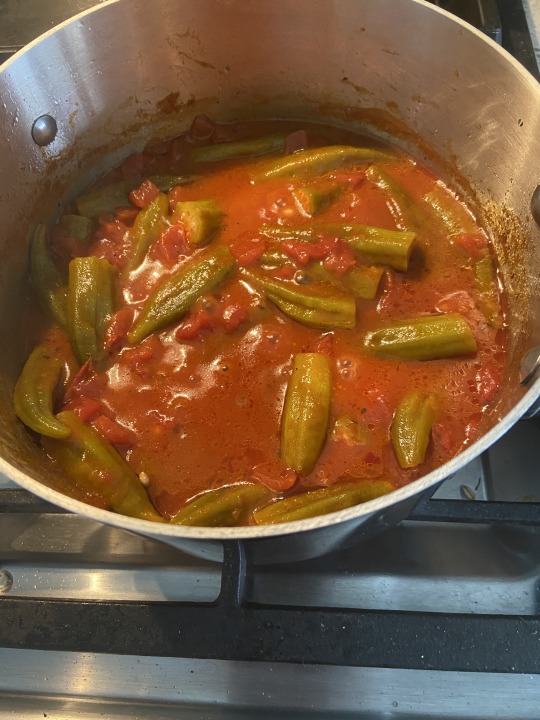
Uzbekistan
The Uzbeki community –known in Israeli as the Buchari community– in Jerusalem might be a tiny fragment of the overall population but it is a notable one. The Bucharim arrived in Jerusalem in several immigration waves from 1890 to 1914. The Russian conquest of Uzbekistan stimulated many to leave and because the community was observant by nature, Jerusalem was a natural choice for resettlement.
Originally, the first Buchari immigrants opted to buy land in the Old City. However, the harsh living conditions behind the walls in addition to their needs as a young and culturally and linguistically unique community drove the Bucharim out to search for their own space. In 1894, after several years of community fundraising, a lot was purchased northwest of the Old City. The new immigrants initially named their new space Rechovot (meaning streets in Hebrew) but it was soon known by all as Shchunat Ha’Bucharim or the Buchari Quarter. Eager to replicate their old community life, the Bucharim hurried to establish communal facilities, such as a senior living home, orphanage, and several synagogues, including the Mosayof synagogue named after the community spiritual leader Rabbi Shlomo Mosayof. In addition, a Talmud Torah school teaching in both Hebrew and Parsi was founded to solve the language barrier problems that young Buchari boys were experiencing when visiting schools in other communities. Unlike other new Jewish neighborhoods at the time that were built simply and in a haste, much thought and funds were put into the urban planning and architecture in the Buchari Quarter. Given the generosity of the wealthy members, the facades of the buildings were embellished with Jewish Stars and other decorations, trees were planted on the side of the roads, and empty lots were allocated for farming. Considered then exotic within the Jerusalem landscape, the quarter attracted visitors from within and outside of Jerusalem to admire its beauty and to explore its vivid community life.

(Above- The Davidof family, one of the most prominent families in the Buchari community, a portrait from the early 1920′s)
Today, Shchunat Ha’Bucharim is still a popular destination and several of the sites are protected by the Israeli Council of Historic Preservation. However, given various demographic and political shifts, the original Buchari population shrank and because of this, many of the structures suffer from neglect. As the quarter borders with Jerusalem’s Ultra-Orthodox residential complex, there is an increasing “invasion” of young Haredi families who cannot find housing in their overpopulated neighborhoods. The growing Ultra-Orthodox presence also impacts the moderate religious nature of the Buchari community, as shown in the Israeli film, The Women’s Balcony.
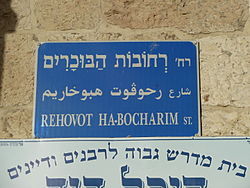
(Above- a street sign in the quarter)

(Above- an example of the Buchari’s quarter unique architecture- the Davidof “Palace”)
The Women’s Balcony (directed by Shlomit Nehama and Emil Ben-Shimon, 2016) is the story of the small but devoted community of the Mosayof synagogue. The men in the community compose a loyal Minyan, and take care of the synagogue maintenance. However, their wives are the burning candle, and the real power behind the joyous life cycle, holiday celebrations, and the community aid. One day, this peaceful life is disrupted. The synagogue ceiling collapses during a Bar Mitzvah ceremony, where the rabbi is badly injured and the structure itself requires serious work. Puzzled by this accident, the men in the community accept the authority of a young charismatic rabbi as their new spiritual leader. The new rabbi is indeed very knowledgeable and committed to repairing the damage, but his religious views are far more radical and do not match the community’s long tradition of religious moderation. The women are the first ones to be affected by his strict agenda. They are excluded from worship and are blamed for being overly permissive when it comes to modesty and Jewish laws. Caring deeply about their community, the women decided to fight back. For more on their struggle, watch the movie on Amazon prime video.
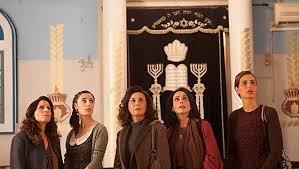
(Above- a scene from the movie)
Although food is not the focal point of the movie, many of the scenes take place in Shuk Machne’ Yehuda, a traditional Middle Eastern Marketplace that is a destination for pre-Shabbat shopping as well as culinary tourism. Zion, one of the characters in the movie, is the owner of a spice store in the Shuck, and is also famous for making delicious fruit salads using fruit from the nearby stands. And indeed, as the movie portrays, the Buchari cuisine very much relies on the use of local and fresh produce as well as aromatic seasonings. Given Uzbekistan’s location in central Asia on the Silk Road, the Buchari food incorporates Russian, Turkish, and Iranian influences. The result is a cuisine that has bold flavors and rich seasonings. Lamb is the favorite meat, and its fat alongside some herbs and leafy green vegetables are highly used to flavor foods. Accordingly, the traditional dishes are Manto- meat dumplings with vegetables and Legman soup made with noodles, lamb and fresh veggies. Similar to the Iranian cuisine rice is the wide-used grain. Bachash, the traditional rice, has many variations from a green one with cilantro, dill, and spinach to a simple white version with thin noodles (or orzo in this case) at the bottom. The movie shows a quick glimpse of a basic white Bachash, and therefore this is the recipe I chose to highlight.
The recipe for Bachash is taken from the book Jerusalem. Palestinian chef Sami Tamimi and Israeli chef Yotam Ottolenghi pay homage to their hometown while curating a plethora of recipes from Jewish, Muslim, and Christian communities. Their seminal groundwork into the Jerusalem cuisine truly helps with understanding the different influences and flavors that make Jerusalem a synonymous name for unique yet comforting food. The beautiful photos, as well as the interesting historical and cultural segments, make this book a nice possession even if not used for cooking.
Unlike many dishes in this book (or in other Ottolenghi’s books), this rice recipe is extremelya to make and does not require any speciality ingredients. My rice recipes are usually taken from the Persian cuisine, which requires longer cooking time and prep. When I made this dish, I was pleasantly surprised how incredibly quick and easy was the process without compromising the texture and flavor.
White Bachash
Ingdientes:
1 ⅓ cup basmati rice
1 tbsp ghee (or butter)
1 tbsp sunflower oil
2 ½ cup chicken/ veggie stock
1 tsp salt
½ cup orzo*


Process:
Rinse rice and soak it for 30 minutes in cold water. Drain and rinse again.
Melt butter and oil on medium heat in the pot.
Add orzo and fry for 3-4 minutes or until orzo turns dark golden.
Add the stock , bring to a boil, and cook for 3 minutes.
Add the drained rice and salt, bring to a gentle boil, stir once or twice, cover the pan, and simmer over low heat for 15 minutes. Try not to uncover the pan- keeping it closed helps the rice to steam properly.
Turn off the heat, remove the lid, and cover the pot quickly with a clean kitchen towel. Place the lid back on top of the towel, and leave for 10 minutes.
Fluff the rice with a fork before serving.
* I used GF chickpea flour orzo, which I think added a nice flavor to the rice.
6 notes
·
View notes
Text
Moroccan Jewry: Magic in the Claypot
In the northwestern tip of Africa, nestled between the Saharan desert in the south and the Iberian Peninsula in the north, once lived the largest Jewish community in the Arab-speaking world. Morocco, on mountainous terrain, and coastal cities, on the Mediterranean Sea and the Atlantic Ocean, were the ancient homes of a diverse and incredibly vibrant community. And unlike other Jewries in the Muslim lands, which ceased to exist soon after Israel’s Independence in 1948, there is still a fairly sizable community in Morocco, residing in the urban centers of Fez, Marrakech, and Casablanca.

(map of Morocco)
But even outside of Morocco, descendants of this great community who today live mostly in Israel and France, still keep strong ties to their old diasporic home. They are proud of their rich heritage and they zealously preserve their old traditions. The Jewish Moroccan legacy is particularly unique within the spectrum of the Jewish culture, and for that reason, it fascinates many ethnographers, historians, artists, and film directors. Evolved in the diverse geopolitical landscape of Morocco, the Moroccan folklore includes rituals and ceremonies that essentially do not exist in any other Jewish community. Perhaps, the most famous one is the Mimoona holiday –a post Passover celebration of sweets and music– that recently regained the status of a national holiday in Israel. More about the unique rituals associated with the Moroccan Jewry are later in this post.

(Traditional food and garments in a Mimoona celebration in Israel)
One of the most interesting things about Moroccan heritage is the marriage between Torah and sorcery. In other words, the important role of Jewish scholarship and the revered role of rabbis did not diminish or even contradict the strong folklore and the plethora of ancient spells, charms, and all sorts of witchcraft associated with it. In many cases, these two forces went hand and hand, and the rabbis not only validated these popular beliefs but also took an active role in cultivating them. In that respect, rabbis addressed issues of how to remove an Evil eye (a gaze or stare superstitiously believed to cause material harm) or instructed to install a Hamsa (amulet symbolizing the Hand of God aimed to keep away grief and bring in prosperity) in one’s entryway. Many rabbis participated and encouraged the practice of Martyrdom, including raising popular rabbis to the degree of a Tzakik or a Kadosh (a saint), and attributing supernatural powers to him. A major part of this tradition was the graveyard worship that included a pilgrim to the martyr’s grave, and collective or individual prayer on-site.

(The grave of Rabbi Amram Ben Diwan in Ouazzane)
The “magical” world of Moroccan Jews definitely transmitted into the realm of the kitchen. Moroccan cuisine is aromatic and flavorful. It utilizes the many spices and legumes available in the region and blends them into a rich distinct taste. The last section of this entry will elaborate more on a specific dish that encompasses many of the Moroccan flavors. But first to better understand the influences on the food (and culture in general), here is a brief historical review.
2000 Years of History in a Nutshell
According to archeological evidence, Jews resided in Morocco, mainly along the coast, as early as the second century CE. Historians assert that Jews were motivated to migrate to this area given its commercial potential as a connecting point of the two sides of the Mediterranean. The mercantile function that Jews filled up from this early stage of history became a thread throughout centuries of Jewish settlement in Morocco.
A pivotal phase in the history of the community occurred in the 15th century as deportees from the Spanish inquisition first arrived to the shores of Morocco. Although information about numbers is insufficient, it is clear that the Iberian refugees were a sizable group within the local community and even the majority in several cities. At first, the newcomers from Spain and Portugal and the locals operated in two separated communities. They worshiped in different synagogues, followed only their rabbis' authority, and resided in different parts of town. Their relationship was also affected by commercial rivalry and language barrier since the Megorashim (Hebrew for deportees) spoke Ḥakétia- a mixture of Spanish, Hebrew and an Arabic dialect- and the native community conversed in Judeo-Arabic, which was basically the local dialect infused with some Hebrew words. Gradually, the two communities bridged their differences and consolidated into one Jewish community. An important landmark in this process was the writing of the Jewish laws book of the city of Fez in 1698, which was a collaborative effort of religious leaders from both sides to find common ground. The Fez precedent was later fostered in other towns in Morocco, and it became the religious codex followed by the entire Moroccan community to this date.

(Jews in Fez during the 20th century)
In Morocco, as it was in other places in the diaspora, Jews were frequently subject to the temper and political agenda of the local ruler. Generally speaking, in the pre-modern era the Moroccan Jewry lived relatively peacefully and maintained good relationships with their Muslim neighbors. Yet, in certain periods the Jewish community suffered from brutal persecution. A particular painful chapter occurred during the late 18th century under the reign of Sultan Yazid. The latter ordered the slaughter of wealthy community members, and forced others to convert. In addition to occasional violence, Jews in Morocco were also defined as Dhimmis- second class citizens. Under this definition, Jews were granted freedom of worship but were subjected to additional tax and other,often humiliating, restrictions.
Colonialism influenced the history of Moroccan Jews in the 19th and first half of the 20th centuries. North Africa, in general, was an important battleground for the European superpowers and Morocco -as a result- was split between French conquest in the majority of the land and Spanish occupation in the Northern region of Tangier. The French presence was not merely physical or administrative, it opened the door to modernity and European influence. Overall, Jews, particularly those residing in the big coastal centers, were enamored by French culture. Many gain fluency in French, and indulged on French literature and treats. However, only a small affluent elite was guaranteed with the privilege of French citizenship. The majority of the local Jewry was categorized as subjects with limited rights in the colonial rule.

(Moroccan Jewish woman in traditional clothing, circa 1920′s)
In addition, the French rule did not improve the socio-economic status of the local Jewry. Most Moroccan Jews lived fairly meagerly in crowded neighborhoods, called Mellah. Others lived in villages among the Berber population. Craftsmen and small scale retailers were the common trades among men. Women stayed home and ran the household. Boys were sent to Jewish school, named Kutab -a system of schooling similar to the Eastern European Heder- in which the emphasis was Torah study with very little secular education. Only a minority sent their children to private French schools or to the Alliance schools, a Jewish international school network with a strong French orientation. Nevertheless, one should not underestimate the importance of Jewish scholarship among Moroccan Jewry, who generated high numbers of Rabbis, poets, and Talmudic scholars.

(Typical Kutab in Marrakech)

(The Mellah in Meknes)
Jewish life in Morocco continued fairly uninterrupted during the dark chapter of World War II. Yet, although far from the atrocities in Europe, Moroccan Jews were under a constant threat of a German invasion. Moreover, under the rule of the Anti-semitic French Vichy regime- which collaborated with Nazi Germany- Jews were subject to anti-Jewish legislation, aimed to remove Jews from centers of power. Luckily, these laws affected only the small affluent minority, which held public positions and lived outside the Mellah. However, the combination of the hostility of the Vichy regime with the horrifying news from Europe, and the spread of Nazi propaganda in the region created a climate of fear and uneasiness among Moroccan Jews, especially for those living in the big cities. The deep concern about the plight of their brethren in Europe was reflected in various writings of the time. An interesting example of a wartime document expressing solidarity is Haggadah Di Hitler. Written in Casablanca in 1943, after the Allies landing and victory in North Africa, Haggadah Di Hitler creates an analogy between the biblical exodus story and the liberation from the Axis powers. However, the author stresses that the joy over the German defeats in North Africa and on the European fronts (mainly Stalingrad) cannot be completed given the mass murder still happening in Europe.

(The cover of Haggadah Di Hitler)
Zionism brought a major shift in the history of Moroccan Jewry in the 20th century. The longing to revive the ancient homeland was always a thread in the religious life of Moroccan Jews, as Rabbinical scholars led small groups to settle in Israel throughout the centuries. This sense of longing was intensified in the early half of the 20th century. Zionist emissaries from the British ruled Palestine traveled to Morocco to inspire young Jews to become Zionists. New youth movements training for life in the new-old land emerged, and many started brushing up on their Hebrew. However, it was political developments in the regional arena and inside Morocco that created the mass departure of Jews from Morocco towards Israel. Mainly, the Arab-Israeli war starting in 1947 and the rise of the Moroccan National movement, which increased the intolerance towards the local Jewish community. By the early 1960s over 90 percent of Moroccan Jews left. The new state of Israel became the largest center of the descendants of the Moroccan community. Smaller, but still sizable, concentrations can be found in France and Canada (mostly in Montreal).

(Moroccan immigrants arriving to the Haifa port in Israel)
Sepharade- A story that Begins with an Old Moroccan Spell
As mentioned earlier, the physical departure from Morocco did not by any means mean cutting ties with the old Jewish Moroccan tradition. The book Sepharade by Éliette Abécassis exemplifies in much detail how these traditions still dictate everyday life, actions, and decision making for Moroccan Jews living in France and Israel. Abécassis –a decedent of an observant Moroccan family from the city of Fez– wrote this book as a semi-autobiography portraying her complicated relationship with her loving yet binding Moroccan heritage. Her heroine, Esther Vital, a sensitive and reflective girl from the city of Strasbourg in east France, well represents this duality. Although Esther lives in Strasbourg all of her life, she never tries the regional delicacies, visits a local pub, or interacts with her non-Jewish neighbors. In many ways, Esther behaves and dresses as she was living in Morocco. When she is older, Esther attempts her own subtle rebellion to escape her Moroccan Mellah. She cooks healthy food and refrains from the heavy and oily Moroccan dishes, she refuses to wear embellished clothes, and opts for a minimalist french chick, later on she moves out to Paris, seeks a professional life and even dates Ashkenazi and non-Jewish men. But eventually, the family guilt and pressure kicks in, and Esther succumbs to follow the path designated for her: marry a man from her tribe. Beyond the mere family expectations, Esther is motivated by invisible threads, such as ancient spells that were cast upon her family, old rivalries, and more. The main idea in the plot is that one cannot dictate his or her own fate. The mysterious past entails the real powers to shape the life of an individual.

(Éliette Abécassis)
In addition to this core theme, the book is a celebration of the vibrant history and cultural legacy of Moroccan Jews. In France, Abécassis became quite famous as the non-official ambassador of Moroccan folklore. She prolifically wrote about this topic for academic purposes as well as for movie scripts. Sepharade, in this respect, is another attempt to provide a window into this world. For instance, Abécassis beautifully describes the tea ceremonies in the Moroccan household. The tea is served in little glass cups by the matriarch, who whips the tea until its foamy. A thick layer of foam is a testimony of the matriarch’s domestic masterfulness. Another example is the pre-wedding Hena ceremony, in which the bride, the groom, and all of their guests are dancing in traditional garments to the beat of Andalusian music while indulging on colorful sweets. Perhaps one of the most important rituals described in the book is the family get togethers during Shabbats around the Dafina dish. The Dafina is a motif in the book underlying the connection between mother’s cooking and family bonding. For a short history and recipe of Dafina, scroll down.

(Moroccan Hena in Israel)
Dafina: A Dish Buried Deep in Heritage
In many Jewish cultures, Shabbat in winter coincides with a hearty casserole of beans, meats, and grains aimed to satisfy the soul during the cold days. This comfort food dish has different names; Ashkenazi Jews named it Cholent and some Sephardic groups call it Chamin, which stems from the Hebrew word Cham, meaning warm. The Moroccan variation of it, the Dafina, is particularly flavorful as it adds aromatic spices, such as cloves and cinnamon as well as dried fruit.
The name Dafina originates from the Arab word that means buried, alluding to the old custom of placing the dish in the ground. Traditionally, Moroccan housewives prepared this nourishing stew at home: they wrapped the meats in cloth bags, seasoned with an array of spices, added the grains and eggs, and placed it all in a heavy ceramic jug sealed with a layer of dough around the rim. Once ready, the women sent their jug to the bakery for a “burial” in a hot pit. The baker wrote the family name on each jug with a piece of chalk, and delivered it back the next day. Nowadays, people allow the Dafina to slowly cook overnight on the Shabbat hot plate or crockpot (as I did).
Although the Dafina includes basic ingredients that always remain the same, each region and each family has their own variation, and the process of combining and layering them all considers to be true art and a source of pride. Some families filled cloth bags with freekeh seasoned with Ras el Chanoot. Others chose rice dotted with raisins and fried onions. The jewel of the crown of the Dafina is the Koorah, the meatloaf or more precisely the roll of meat, sprinkled with peanuts or almonds and coated with an egg and old breadcrumbs. The Koorah was placed into a cloth tied with a string and the juices from it made the Dafina particularly flavorful.
The Dafina embodies the various influences in the Jewish Moroccan cuisine. The custom of placing a claypot in charcoal-filled pits came from the rural Berber tribes. Certain spices, such as Ras el Chanoot, came from the Arab neighbors, and the usage of almonds and other nuts was brought by the Sephardic deportees. Other famous dishes in the rich Morrocan repertoire are Chramieh,fish cooked in tangy tomato sauce; Pastilla,fillo dough filled with meat and spices; and Sfenj, donuts heavily coated with honey.
There are many sophisticated recipes for Dafina floating online. Below, however, is a quick vegetarian version for a busy household. Perhaps, it is not as filling as the meat-based one, but it is still just as wholesome and comforting.

Lazy Vegetarian Crockpot Dafina
Ingredients:
Salt
Fresh ground pepper
4-6 hard-boiled large eggs
Pinch of saffron threads, crumbled
1/2 cup chopped fresh parsley
1/2-1 teaspoon turmeric
1/2 teaspoon cinnamon
1 teaspoon of ground cloves
1 tablespoon paprika
2 teaspoons ground cumin
2-3 sweet potatoes, cut into chunks
4-6 dates
2 small potatoes
1/2 cup of barley (farro or freekeh will work well too)
2 15 oz cans chickpeas rinsed and drained (fava or northern beans are also good)
4 tablespoons extra virgin olive oil
2 large onions, chopped
4-6 cloves garlic

Preparation:
1. Once you’ve prepped all the ingredients, place them in the crockpot. Put the onions and garlic first with 2 spoons of oil. Then layer potatoes and sweet potatoes, beans, and barley. Afterwards, mix in the spices, dates, and the rest of the oil. Save the eggs for the top.
2. Set crockpot to low heat and allow to cook for at least 6 hours or overnight.
3. Enjoy your Dafina on Shabbat morning or any other time.
7 notes
·
View notes
Text
Encountering a tiger by the Well: Stories from Rural Yemenite Communities
Now comes the story of a community that is so distinct and fascinating that it deserves its own blog. The Yemenite Jewish community is large in size and presence, and historically and culturally different from the general Sephardic diaspora. However, for various reasons, mainly the human need to classify, Yemenite Jews are often included under the Sephardic umbrella.
Living in a fairly remote location shaped the distinct folklore, liturgy and cuisine (more on that later) of the Yemenite community. And although Yemenite Jews were not detached from the major events happening in the Jewish world, local factors such as Yemen’s history, diverse terrain (jungle, seaside or dessert) and wildlife were the most influential. Another striking characteristic of the Yemenite Jewry is its demography: the majority of Yemenite Jews resided in villages scattered around the land - often one or two families per village. However, despite being surrounded by a (frequently hostile) Muslim majority, Yemenite Jews maintained a very observant Jewish lifestyle. A book that portrays this arduous and yet unique existence in the first half of the twentieth century will be reviewed later in this post entry. But first, here is a brief overview of the Yemeni community.
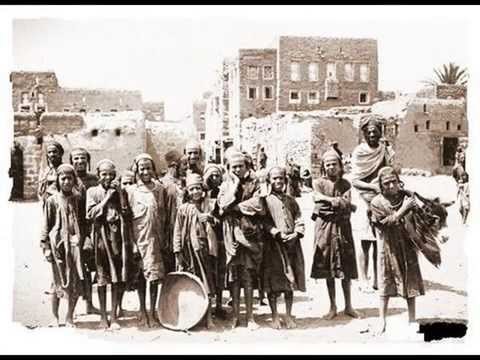
Historical Glance: From Queen Sheba to Zionist Aspirations
Jewish Monarchy in Late Antiquity
Yemen’s current status as a poor and divided nation obscures the country’s glorious past as an ancient civilization known as the fertile oasis of the Arabian Peninsula. Jews immigrated to this promising land fairly early. Biblical texts (Book of Ezra) indicate a Jewish settlement in Yemen circa the destruction of the First Temple (587 BCE). Another legend says that Yemeni tribes converted to Judaism after the Queen of Sheba's visit to King Solomon.Yet, historians assert that the Jewish immigration took place later, starting in the second century CE. Regardless of this dispute, all sides consent that Jews were a key political and economic force during the pre-Islamic era.
A prime example of their power occurred in the 6thcentury when the kingdom’s aristocracy converted to Judaism. Some sources suggest that the king himself, Joseph Dhu Nuwas,was zealous for Judaism.According to these sources, Dhu Nuwas sought to convert Yemeni Christians to Judaism, but they refused to renounce Christianity. What exactly happened afterwards remains murky given the conflicting accounts. Yet, it appears that Dhu Nuwas died as part of the religious rivalries. His death ended the Jewish hegemony in Yemen.
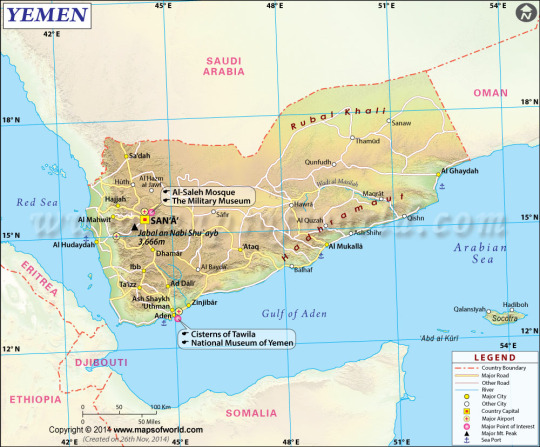
Maimonides and Messianic Aspirations
The 7thcentury Muslim conquest of Yemen marked a negative shift in the history of the Jews in Yemen. Historical knowledge about these early stages of the Muslim reign in Yemen is limited, but several sources from the Cairo Geniza indicate that the Jewish community was in a plight. The new Sharia law defined Jews as Dhimmis- or second class citizens. In essence, Jews were granted with freedom of worship but were subjected to additional tax and other (often humiliating) restrictions.
Although Islamic law categorized Jews as a protected minority, Jews suffered ongoing persecution under the various Muslim rulers. From the 10thcentury on, the living conditions of Yemeni Jews deteriorated significantly as the relatively tolerant Sunni sovereign was overthrown by the radical Zaidis (a Shia sect) dynasty. In the 1160s, the local ruler Iben Mahdi forced Jews to convert to Islam. As a result, a false prophet arose, proclaiming the amalgamation of Judaism and Mohammedanism. This messianic revival evoked the concern of Maimonides. The latter addressed the Jews of Yemen in an epistle, entitled Iggeret Teman,in which he urged them to remain faithful to their religion. The intervention of a scholar of that scale had a great impact on the Jews of Yemen; the false prophet was condemned, and thename of Maimonides was added to the Yemenite version of the Ḳaddish prayer. The defeat of Iben Mahdi in battle in 1173 and the conquest of Yemen by the brother of Saladin brought relief to Jewish community and those who had been forced to convert reverted to Judaism. Around this time, two sub groups were formed among the local community: theShami, who partly assimilated into the Sephardic culture and liturgy; and the Baladi, who followed Maimonides, especially the rules in his “Mishneh Torah”. Both sub groups fostered the mysticism prominent in Sephardic traditions.
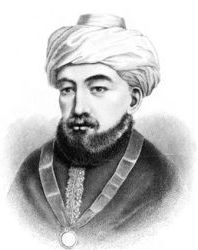
Above: Maimonides
The Modern Era: Zionism as the New Messianism
Fasting forward to modernity, the 19thcentury brought dramatic change in the life of the Yemenite community. At this time, the population was divided between the minority, who lived in urban-gated centers (such as, Sana and Aden), and those who resided in remote villages surrounded by Muslim neighbors. Commerce and craftsmanship (including carpenters and blacksmith) were common trades. Regardless of location and profession, the life of the average man was rough. The community was subjected to the jurisdiction of the local Imam (Muslim Zaidileader), and suffered from endless restrictions, limiting their transportation and monetary transactions.
The most notorious act enforced by the Zaidi rulers was the Orphan’s decree, which mandated the Zaidi government to take under its protection and to educate in Islamic ways anyJewish child whose parents had died when he or she was a minor. Accounts from this period portray numerous cases of abduction and forced conversion of children. As a measure of protection, child marriage became increasingly prevalent. Another consequence of this plight was yet again intense messianism, including three incidents of pseudo-messiahs in the second half of the 19thcentury.
Under these circumstances, Zionist ideology spread by emissaries from Palestine found a good nesting ground. During the period from 1881 to 1914, about 10% of the Yemeni Jews immigrated to Palestine (the rest immigrated in the late 1940’s and 1950’s). Many died during the dangerous journey, and those who made it were recruited to work as cheap labor in the new Zionist settlements. They were housed in barns and provided with meager food and water. The exploitation of Yemenite Jews reveals an ugly chapter in the history of the early Zionist history. This tragedy opened the path to even more horrifying cases of discrimination, and mainly to the explosive affair of the possible abduction of Yemenite babies and toddlersin 1950’s Israel. According to this controversial case, the abducted Yemeni children were sold or given to Ashkenazi families, mainly to Holocaust survivors who could not have kids. The State of Israel firmly denies all allegations.

Above: Yemeni workers in Kinneret
Sapri Tama Tamimaby Sarit Gradwohl
In the context of the turmoil of the first half of the 20thcentury, the book Sapri Tama Tamimaby Sarit Gradwohl offers a fascinating lens to explore the world of rural Yemenite Jews and their uneasy immigration process to Israel. Gradwohl recorded the personal accounts of her grandparents (mainly her grandma) and weaved them into a captivating novel. Gradwohl’s family memoire begins in a small isolated village in Yemen. Her grandmother, Hamama, is then a young child curious about the world. Through her childhood memories, we discover the rough existence, including constant harassments by Yemenite soldiers, the limited food and the presence of wildlife. One of the saddest stories in the book is the death of Hamama’s younger sister from a heart failure after encountering a tiger by a well.
As Hamama matures she falls in love with her cousin, Hassan, a resourceful and fervent Zionist. Soon after their marriage, they embark on the treacherous journey to Israel, then mandatory Palestine. In 1942, they finally made it to the Promised Land, only to be placed in a transit camp by Haifa. Then begins their second adventure. They face many challenges, including living in tents for several years and suffering from prejudice by the Ashkenazi population. In addition, coming from traditional households, they are also bewildered by secular Judaism and cannot grasp how the Kibbutznikim and the Zionist leadership strayed so far from Jewish law. Yet, despite the barriers and through hard work and perseverance, Hamama and Hassan built a happy life together with a strong sense of family.
Last November, I had the pleasure to meet with Sarit Gradwohl in her house in Skokie. In our fascinating conversation, Gradwohl shared additional insights about her grandparents’ immigration to Israel. From her perspective, they acknowledge that they were mistreated in certain times, but they never labeled these experiences as discrimination nor did they harbored resentment towards the State of Israel. They remained, she proclaimed, innocent in heart and faithful to their core values: the love for Judaism and the land of Israel.

Above: Gradwhol and her Grandfather
Lasis-A Dish Worth Fainting
When I met with Gradwohl, we talked more about her grandma’s special delicacies, particularly Asid Va’zom, a dairy soup/ porridge eaten at the end of Yom Kippur, and her aromatic lentil soup. She also told me about her grandma’s Jachnun making techniques. This dense pastry dish became a Shabbat breakfast staple in Israel, served savory with mashed tomato and hardboiled egg or sweet with honey. Some buy it frozen, but it is best homemade cooked overnight on the Plata (the Shabbat hot plate).
Despite the popularity of doughy Yemeni dishes, such as Jachnun and Malawach,Gradwohl debunked the common misconception in Israel that the key ingredient in Yemeni food is starch. Backed with academic research, Gradwohl argued that traditional Yemeni cuisine is mainly composed of fish, legume and grain dishes. The use of puff pastry type dough was a later Turkish influence. Gradwohl also added that Yemenite families did not suffer as much as Ashkenazi families during the austerity period in 1950’s Israel, in which eggs and dairy products were rationed. Since Yemenite women were skilled in making beans and lentils dishes, they were able to create nourishing meals using simple plant based ingredients.

Above: Jachnun
An example of a basic legume dish is the Lasis, a slow cooked bean dish served on Shabbat. One of the most endearing stories in the book is the anecdote about little Hamama marching for hours with a jug of Lasis on her head. When she finally arrives home, her siblings falsely accuse her of stealing the favorite dish. Infuriated she runs away outside of the village, where she is nearly attacked by monkeys. Overly excited she runs back home, and receives the Michva treatment- a tribal remedy used to calm the agitated. After the hot iron rod is placed on her head, she faints.
Lasis might not be a reason for a family drama, but it is definitely worth making at home. It is easy to make, satisfying and delicious. Below, is a recipe recommended by Gradwohl. Slow cooking the beans overnight definitely helps to accentuate the flavor.
Lasis
Ingredients
2 cups - red kidney beans
0.5 tsp - baking soda
Salt
water
4 hard-boiled eggs
Cumin
Schug(Yemeni hot sauce)/ Jalapeno based hot sauce
Making
1. Soak beans overnight with baking soda
2. Drain and rinse beans
3. Place beans in slow cooker or pot with hard-boiled eggs and salt, cover with water and let it cook very slowly
4. Serve with a generous sprinkle of cumin and drizzle some chug

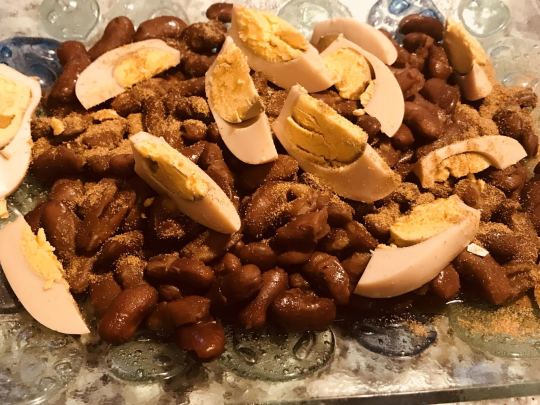
Above: Lasis in the making
The Great Yemeni Cultural Contribution
This blog entry would not be complete without paying tribute to the rich cultural contribution made by Yemeni Jews to Israeli society. From the colorful Hinna (pre wedding) celebrations to Yemenite folk dancing, Yemenite Jews deeply influenced mainstream Israeli culture and particularly Israeli music. In the sea of great artists, I would like to highlight three particularly inspiring ones.
Zohar Argov (1955-1987)
In his short sad life Zohar Argov redefined the Israeli music scene. His distinct sound brought the Yemeni Piyutim (liturgical chants) from the synagogue into the ears of every Israeli, and created the genre widely known today as Muzika Mizrachit (Oriental Music). Initially, his music was turned down by the local radio stations, but through pirate cassettes and unforgettable performances Argov became a legend during his lifetime. Despite the catchy tunes, Argov’s lyric are often somber, addressing drug addiction and loneliness. Fame did not cure his mental issues, and Argov put an end to his life at age 32. However, his legacy is long lived by many Israeli musicians today, who still refer to him as HaMelech (the King). Below is his most famous hit- Ha’Pereach Be’Gani, a must have in every Israeli wedding to bring people onto the dance floor.
youtube
Ofra Haza (1959-2000)
Ofra Haza was one of the most popular singers in Israel in all times. Having a sweet tender voice and being extremely beautiful, it was hard not to be a fan. During the 1980’s and 1990’s she was everywhere: kids TV shows, movies, national ceremonies and on teenagers walls. In 1983, she touched the entire Israeli nation when she performed the song Chai (Alive) in the Eurovision Song Contest in Munich Germany, only 30 kilometers from the Dachau Concentration Camp. Haza was also a renowned artist outside of Israel, taking a lead role in the Ethnic Pop wave in 1980’s Europe. Her breakthrough as an international singer happened in 1984 after she released the album Shirei Teiman (Songs of Yemen), which consisted of songs she had heard in childhood, mixing authentic Middle Eastern percussion with dance bit rhythms. Throughout her career, she earned many platinum and gold discs and was nominated for the Grammy award. Like Argov, Haza died young at, at the age of 41, of AIDS - related pneumonia
Below is the song Im Nin’alu a prime example of her ability to combine an ancient liturgical poem with a catchy tune. The beautiful video clip was set to emulate the landscape of Yemen.
youtube
Adi Keissar (born 1980)
Adjectives, such as provocative, uncompromising and straightforward, do not begin to describe the pungent poet Adi Keissar. Born and raised in Jerusalem, Keissar is using her poetry to criticize Israel social illnesses, and to spread her own agenda of prompting the culture and civic rights of Mizrahi Jews. Keissar strongly objects to the elitist reputation of poetry, and therefore she established the Ars-Poetica club, where poets from different walks of life come to share their words. Besides poetry, the Ars-Poetica club offers a fun celebration of Mizrahi culture, including belly dancing performances and Sephardic food banquet. Because of her sharp tongue and natural charisma, Keissar made poetry relevant again. People memorize her poems by heart, and she inspired so many others to follow her path. Below is a video clip of one of her inspiring poems.
youtube
3 notes
·
View notes
Text
Benghazi A North African Holocaust
Between the Mediterranean Sea and the Saharan desert lays the second most populous city in Libya- Benghazi. Similar to other ancient Sephardic centers explored in this blog (e.g., Aleppo and Baghdad) Benghazi is nowadays mostly associated with “bad news”. The last decade or so has been rough on Benghazi. While the “Arab Spring” revolt ended Gaddafi’s brutal dictatorship, it also brought much destruction and chaos to the city, which was apparent from the 2012 attack on U.S. government facilities and the increasing ISIS activity.

(Above: The seafront in Benghazi)
While the future is uncertain for the people of Benghazi, the past is a source of pride for those with a connection to it. As a bridge between the Mediterranean Sea and Africa, Benghazi was an important political colony during the Greco-Roman period, and it later served as a strategic port of the Ottoman Empire. In 1911 Italy conquered Libya and made Benghazi a political and cultural stronghold of their colony. The Italian chapter (1911-1943) in Benghazi marked a new era of western influence in the history of the city. For the local Jewish community, the Italian rule presented both great opportunities due to European exposure (see impact on the cuisine ahead) as well as tragedies during the Second World War. This post will elaborate on the events of this period.
From Berenice to Jado: A Brief Historical Overview
The Jewish community of Benghazi is one of the most ancient communities in the Jewish diaspora. Jews settled in Benghazi as early as the 4th century B.C.E under the Greeks’ reign, and remained there until the late 1940’s. Not a single Jew remains in Benghazi today.

(Above: Roman ruins in Benghazi)
Historical evidence from the Roman rule (74 B.C.E) indicates that Jews in Benghazi then called Berenice, enjoyed juridical autonomy and the privileges of Roman citizens. From 115-118 C.E., members of the Jewish community participated in a revolt against the Romans. During the Byzantine era Jews suffered from constant persecution. The residents of Bernice, including its Jewish ones, fled with the Arab conquest of 660 C.E. The Arab conquerors later changed the name of the city to Benghazi (Bin Ghāzī). In the beginning of the 16th century, many Jews from Tripoli helped to repopulate Benghazi, earning their livelihood trading throughout North Africa and the Mediterranean area, or as smiths or tailors. The community continued to flourish both under the Ottomans (beginning in 1640), particularly after the arrival of Jewish merchant families from Italy.
In the 18th and 19th centuries Benghazi had 400 Jewish families divided into two groups: those originally from the city and its surrounding district of Cyrenaica (Kahal Bengazi) and those who were born in Italy or Tripoli. Although both groups recognized the authority of one rabbi, each had its own synagogue. It was a time of relative prosperity given the important role of Jewish families in reviving Benghazi as a trading center connecting Europe and Africa. Because of their commercial activities, Jews were not confined to specific area of town (unlike communities in Morocco and Tunisia), and several affluent men occupied high positions in the service of the Ottoman authorities.

(The Great Synagogue in Benghazi)
The Italian rule (beginning in 1911) attracted more Jews from the interior of the country, as well as from Italy, to Benghazi. Although the majority of the community remained loyal to Jewish practice and kept conversing in the traditional Judeo-Arabic dialect, the Italian influence grew stronger, especially among the elite. Enchanted by Italian culture, many Jews fostered Italian as a second language, purchased Italian products, and added pasta and other Italian dishes to their kitchen (see more below). The admiration of Italy was a rather unique phenomenon in the North African landscape, as other regional Jewries (particularly the Algerian communities) were defined by their strong orientation to France
Life under Italian rule continued peacefully for the Jews until 1938. Then, as residents of an Italian Colony, Libyan Jews were subjected to the Racial Laws, enforced by the alliance between Hitler and Mussolini. The discriminatory legislation was aimed to deny Libyan Jews from positions of power, to segregate them by prohibiting marriages with Europeans and to expel Jewish students from Italian schools.
The opening of the North African Front of World War II and particularly the Western Desert Campaign in 1940 marked further a decline in the situation for Libyan Jews. The Allied air raids on the major cities and the growing shortage of food increased the hostility against the Jews. The circumstances were particularly harsh in Benghazi and in its surrounding district of Cyrenaica, where the reoccurring exchange of power between the British forces and Italian army put the pro-British Jewish community in a vulnerable position. Jewish families from the region holding British citizenship were the first to be sent to detention centers in Italy, and later with the German invasion to Italy (1943) to Nazi concentration camps in Germany and Austria, mainly to Bergan-Belsen.

(Above: Holocaust survivors return to Libya from Bergen Belsen concentration camp, 1945)
The novel Benghazi-Bergen-Belsen by Israeli author Yossi Sucary sheds light on this unknown chapter of the Holocaust. The story was inspired by Sucary’s grandmother memoir, a survivor of Bergen-Belsen. In interviews, Sucary shares how his elementary school teacher definitively declared that only European Jews suffered from Nazi’s atrocities. The denial of his family story drove him to write this beautiful novel that bears important historical facts. The book has received several awards and was recently adapted into a play.

(Above: Yossi Sucary)
The book portrays the journey of Silvana Haggiag, a bright and urbane girl from Benghazi. Silvana is very passionate about her hometown, and her recollections unfold a happy childhood with strong family ties. Yet, she refuses to succumb to the patriarchal paradigms of her time, as she furthers her education and experiments with romantic affairs with non-Jews. Her world, though, comes to end one day, when she and her family are violently uprooted from their home. After being deported to several camps, she arrives to Bergen-Belsen. There, in addition to the hunger, mental distress and other hardships, she is being segregated for being different among the inmates. As an exotic, dark-skinned Jew, she suffers from language barriers (not understanding Yiddish) and from sexual assaults. Below is excerpt describing Silvana’s first moments in Bergen-Belsen (translation from Hebrew- H.M.):
“’Welcome to hell, Black Woman’ these were the first words she heard in Bergen-Belsen, coming from the mouth of an older man with a long face. ‘We are all Jews in here’. If it weren’t for his deep despair, he would resemble one of the Rosenzweigs she met in Benghazi. Almost all the Jews she saw in Bergen-Belsen seemed to her like members of the Rosenzweig family. Unlike her and the rest of the Libyan Jews, who went down the train car, all the prisoners in Bergen-Belsen had fair complexion. When the entered the camp Toni said: ‘there are Jews here that don’t look like us.’”
(Bengahzi-Bergen-Belsen, p. 224)
In addition to the deportations to Europe, more than 25,000 Jews, many of them from Benghazi, were deported to interment camps in Libya. The Jado camp, operated between May 1942 and January 1943, in the Tripolitania area was the largest one and most widely known among them. Survivors of Jado describe the rough living conditions in the camp, emphasizing the meager food rations, the severe space deficiency, the hard labor, and the typhus epidemic. In their accounts, they highlight the brutality of the Italian guards, which added to the general state of fear and panic. By the time the camp was liberated by British soldiers in early 1943, there were 562 dead out of the approximately 2,600 Jews deported. This is the highest number of Jewish casualties in a Muslim country during the Holocaust. Nevertheless, this number would have been higher if not for the Allies’ victory in Libya.
Learning about the mass murder of European Jews and escaping a similar fate, generated feelings of hope and redemption among the Jado Survivors, and Libyan Jews in general. These feelings and the growing intolerance towards the Jewish community, strengthened Zionism among Libyan Jews. Israel’s Independence in 1948 made it possible for most Libyan Jews to find refuge in the new country and make their dream a reality.
Shakshuka and Beyond: The World of Jewish Libyan Cuisine
Since it is hard to isolate the Benghazi Jewish cuisine from its regional context, this segment will refer to the Libyan Jewish culinary tradition as a whole.
The Libyan Jewish cuisine has been shaped throughout the centuries from a wide array of factors including geographical location (desert and sea), the presence of foreign rulers (primarily Italian), the influence of the local Arab and Berber cooking and kosher dietary laws. As a result, Libyan Jews cook a variety of fish dishes, rely heavily on semolina as a primary grain (for Couscous and desserts) and favor lamb as their meat.
Gueta, a popular restaurant in Israel, prides itself for serving authentic Jewish Libyan food. According to the owners a typical meal will begin with a selection of appetizer salads, such as Pilpel Choome (spicy pepper spread) and Chirashi (pumpkin salad); the entrée will include Couscous, Mafroum (meat stuffed potatoes), and Chraime (fish with red spicy sauce); then finally for dessert peanut spiced tea and Sfara (semolina cake with dates).
In addition to the dishes mentioned, perhaps the greatest contribution of Libyan Jews to the Israeli/Jewish culinary repertoire is Shakshuka. Traditionally, a simple skillet of piquant sautéed tomatoes and sunny side eggs, Shakshuka is the quintessential Israeli comfort food. Whether for breakfast or dinner, from a premade mix or fresh chopped veggies, either with runny eggs or hard yolk boiled, Israelis are passionate about their Shakshuka. Albeit a rather straightforward dish, Israelis love discussing their tips and recipes. Since it is so simple to make, it is not a rare sight to see campers or IDF soldiers cooking shakshuka outdoors on portable stoves. In restaurants, one can find a whole section of Shakshukas. Balkan (with eggplants, olives and herbs), Galilee (with spinach and goat cheese) and Merguez (Spicy sausage) are just a few examples of the Shakshuka obsession. Recently, this trend made its way to restaurants in the U.S., where American chefs are now crafting their own version.
Perhaps one of the experts on the matter is Bino Gabso, also known as Doctor Shakshuka. Gabso, the chef and owner of Doctor Shakshuka, was one of the first to bring Shakshuka from home to restaurant. After years of attracting people from all over Israel and the world to his little dive in Jaffa’s flea market, he has achieved celebrity chef status and is now selling his Shakshuka mixes at stores and demoing his skills on TV shows. Below are some of Gabso’s tips, followed by his recipe for a classic Libyan Shakshuka:
1. Tomatoes: Fresh, bright red and ripe! Shakshuka is all about yummy tomatoes, so pick good ones.
2. Paprika: Use a generous amount of high quality sweet paprika. The paprika absorbs the tomatoes’ liquids, and adds much zest to the dish.
3. Eggs: Gabso insists that room temperature is key in order for the egg whites and yolks to harden at the same time.
4. Oil: The recipe does require a lot of oil. In order to make it healthier, lower the flame when the Shakshuka is almost done. After a minute, the oil will appear in the rim of the skillet. At that point, cover the skillet, and tilt it to pour out the oil.

(Above: Doctor Shakshuka in action)
Doctor Shakshuka’s: Classic Shakshuka Recipe
Ingredients for 4 people:
¼ cup canola oil
1 thinly sliced chili pepper
10 garlic cloves minced
Feta cheese, cubed (optional)
8 sliced tomatoes
Salt
1 spoonful sweet paprika
Chili flakes
6 eggs


(Above: the prepping)
1. Warm oil in the pan. Add chili pepper and fry it.
2. Add garlic, and fry for one minute.
3. Add tomatoes and salt. Let it simmer until the tomatoes are softened.
4. Stir in paprika.
5. Break the eggs, and cook until they are ready.
6. Add cubes of feta cheese
7. Serve warm with fresh bread.

(Above: Final result)
Be’teavon (Hebrew- enjoy eating)
1 note
·
View note
Text
The Jews of Baghdad: A Long History Stuffed in a Pita
Formerly the prosperous capital of the Arab Caliphate, Baghdad is now synonymous with quintessential cliché of the rise and fall of a metropolis. The tragedies of this once great city did not pass over its Jewry. Beginning in the 12th century, Baghdad was home to a prominent Jewish community renowned for its rabbinical scholarship. The Jews in Baghdad followed the footsteps of their ancestors, the sages who composed the Babylonian Talmud. Creating the most canonical Jewish texts, the Jews of Iraq and particularly the Baghdadi Jewry contributed indispensably to the world of Jewish knowledge from ancient times through modernity. The intellectual wealth was strengthened by a rich culinary heritage crafted from the vast agricultural resources found in this fertile land (more on this topic ahead).

(Above: A group photo of prominent Rabbis in Baghdad taken in 1906)
The Last Chapter in the History of Iraqi Jews: The Zionist Underground
To give justice to the rich history of the Jews of Iraq and its capital Baghdad requires the word count of a book or a lengthy dissertation, so I will start with the decline. Despite continual shifts in power between rulers, for centuries the Jews were able to tactically navigate the political situation and maintain their commercial strength and religious practice. However, the events of the 1940s and 1950s presented new challenges. In particular, the influence of racist ideologies in Europe, the emergence of the Iraqi national movement and the foundation of the state of Israel increased the hostility and gradually made the life of Jews in Iraq unbearable.

(Above: Anti-Jewish demonstration in Baghdad in the 1930s)
The intolerant climate was characterized by frequent anti-Jewish slurs made both in the political arena and in the streets and even the execution of several well-to do Jewish men. The most traumatic event though was the Farhud, or the pogrom against the Jews of Baghdad (June 1-2, 1941), resulting in over 180 Jewish casualties, and hundreds of Jewish homes and businesses plundered. The riots truly scared the entire community, and made it clear to many that after 2,500 years of relatively peaceful existence, Jews were no longer welcome in Iraq.
One of the results of this growing sense of threat was the establishment of the clandestine Zionist movement in Iraq, predominately led by the daring members of the Baghdadi chamber. These young men and women were inspired by classic Zionist writings and by the social ideals of the Kibbutzim. Living in the most ancient diaspora, they dreamt of escaping the oppression and being equal citizens in their own state. As part of their mission, they worked to spread Zionism among the community, organized self-defense initiatives, and coordinated escapes from Iraq to Israel. Given the anti-Jewish sentiments of the Iraqi government, which increased substantially after the Israel’s independence in 1948, the members of the Zionist movement were targets of a brutal persecution campaign in which hundreds were arrested and several were executed.
“Farewell, Baghdad” by Baghdad born author Eli Amir tells the story of the Zionist underground while providing a panoramic view of the Jewish society in Iraq before the mass immigration to Israel. The book, later adapted into a movie, beautifully demonstrates the disparate reactions to the Zionist idea. Some share the messianic enthusiasm of returning to the ancient homeland. Others are deeply rooted in their diasporic identity and are nostalgic about the old days when Jews and Muslims coexist.
Beyond the antagonism around Zionism, the novel embodies dualism towards the oriental diaspora: on one hand, it describes, using somewhat erotic metaphors, the charm of eastern culture, specifically the food, music and dance; on the other hand, it manifests an aversion to it, primarily the prevalence of superstitious belief, the corruption and the discrimination against women.
Following historical events, the book brings us to Israel, where most Iraqi Jews found refuge. However, the real tragedy happens here - the place where dreams were supposed to come true. The book follows the journey of Abu-Kabi, a true Zionist, who fails to adjust to the mentality of the new state. After facing numerous challenges and mockery, he sinks into depression. In addition to focusing on the miserable Abu-Kabi, the book also sheds light on the many struggles faced by the new Iraqi immigrants, including the rough living in tent compounds, the shortage of food and other essentials and, above all, facing discrimination because of their origin and Arabic accent. Yet, despite the difficult immigration experience, the book encompasses the hope that things will get better with time and hard work.

(Above: Iraqi Jews arriving to Israel in 1951)
Iraqi Food
Time and hard work is also the formula that makes Iraqi food so delicious and well liked in Israel. The exhausting day jobs and the lack of traditional ingredients did not keep the new immigrants from preserving their laborious dishes, which often requires hours of rolling dough and cutting. The flagship of this cuisine is the Kubbeh - a dumpling with different fillings. Unlike the Kubbeh (or Kibbeh) served as an appetizer in Middle-Eastern restaurants around the United States, the Jewish Iraqi Kubbeh is normally served in a soup. Additionally, Iraqi Jews prepare over twenty types of this savory dumpling for different occasions. The most famous ones include Kubbeh Selek (meat based Kubbeh served in a purple beet soup), Kubbeh Hamusta (meat based Kubbeh served in a sour lemon soup), and Kubbeh Barooz (made with fried rice and eaten during Passover). Click here for a recipe and to learn more about the popularity of Kubbeh in Israel.

(Above: Kubbeh Selek)
While some dishes like Kubbeh remained the same, the Iraqi traditional Saturday morning breakfast changed tremendously to fit the lifestyle and palate of the average Israeli. The breakfast, which was originally served as a spread of mezzes (small plates) became a popular street food eaten 24/7, known as Sabich. The primary ingredients (including fried eggplant slices, Tahini and egg) are now stuffed in a warm pita, similarly to other common fast-food sandwiches such as, shawarma and falafel.
Being an Israeli favorite, Sabich is served as a sandwich in numerous cafes and stands all over the country. However, one cannot say Sabich without acknowledging its most famous Patron- Oved. In a small little joint in Giv'atayim (basically a suburb of Tel Aviv), Oved works relentlessly to serve what he proudly names as “the best dish in the universe”. And he is not the only one who claims that. The walls of his establishment are full of photos of Israelis travelling all over the world carrying a sign: “Oved’s Sabich is the best dish in the universe”. Gimmick or not, Oved’s Sabich definitely deserves many praises. His eggplants are always perfectly crisp, the hard-boiled eggs are warm and brown from slow cooking, the hummus is delicious and the Israeli salad is always fresh. Oved’s legendary personality is also a bonus. Always energetic, Oved prepares each sandwich to order using language taken from the Israeli soccer world. Despite our ignorance of Israeli soccer, my husband and I are big fans of Oved, and we make a point to stop there at least once during every trip to Israel.

(Above: Oved in action)
Recipe:
Israeli chef Yotam Ottolenghi and his partner Palestinian chef Sami Tamimi created their own fancy version of the simple Sabich. Served as an open-faced tartine, this dish is definitely worth the effort. Below is the recipe adapted from their book Jerusalem.
Ingredients:
2 large eggplants
1¼ cups of sunflower oil
4 slices of white bread (I used a baguette cut diagonally)
1 cup Tahini sauce (raw Tahini mixed with lemon, garlic and water)
4 large hard-boiled eggs, peeled, and cut into slices
Optional: 4 tbsp of Zhoug (any type of hot sauce that is green chili and cilantro based should work)
Salt and pepper
For Israeli Salad:
2 medium tomatoes cut into cubes
2 mini cucumbers diced
2 green onions thinly sliced
1½ tbsp chopped parsley
2 tsp freshly squeezed lemon juice
1½ tbsp olive oil
Preparation:
1.Peel eggplants skin from top to bottom. Leaving the eggplants with alternating stripes of black skin and white flesh. Cut both eggplants widthwise into 1-inch slices. Sprinkle both sides with salt, spread on a baking sheet and let stand for at least 30 minutes. Use paper towel to wipe excessive water.
2. Heat sunflower oil in a wide frying pan. Fry cautiously each side for about 6-8 minutes or until tender in the center. Once done, absorb the oil with a paper towel.
3. Make the Israeli salad, mixing all the ingredients together with some salt and pepper.
4. Now, assemble the dish: Place one slice of bread on each plate, and spoon the Tahini sauce. Then, arrange the eggplant slices on top, and place the eggs over them. Drizzle some more Tahini and Zhoug. Serve the salad on the side.

(Above: The final result)
Enjoy!
1 note
·
View note
Text
Alexandria – The Diaspora within the Diaspora
Close your eyes and imagine you are traveling back in time and space. You are sitting at a seaside restaurant patio drinking a glass of wine. The ocean breeze gently blows the leaves of the palm trees. At the table next to you sits a beautiful woman dressed in a fine light suit, chatting in French. You cannot help but listening to her story interrupted only by the long inhales from her cigarettes. She is talking about the new Patisserie that recently opened just down the street. Their croissants, she exclaims, are the best! “Alores”, she concludes “Even better than Paris”. All around you are couples dancing to the soft melancholic music being played by the band. It’s just another beautiful night in late 1940’s Alexandria, Egypt. Don’t forget to order the Arabic coffee - they say it’s the best.
So much has changed in Egypt as a result of the geo-political and socioeconomic instability of the last 70 years - particularly the Officers’ Coup D’état (1952), the Islamic radicalization, the growing poverty and widespread human rights violations. Alexandria, the second largest city in the country, was not spared from this dreary reality. However, as an important port city, Alexandria has managed to attract people from different nationalities and to keep its original charm.

(Above: The port in Alexandria)
One group of people longing for the city’s glorious past are the Jews who were forced to leave the city in the 1950’s given the animosity between Egypt and then the brand new State of Israel. The Alexandrian community had a notable place in the Alexandrian landscape. Like the city itself, the local Jews were a vibrant multi-cultural entity. They may have lived on the Mediterranean coast, but they looked northwest towards Paris for cultural cues and trends. Alexandria’s cosmopolitan appeal allured Jews from all over Europe and the Near East (more on that later).
The Jewish Community in Antiquity
The Jewish fascination with Alexandria began early on in Ancient Times and there is evidence of Jewish presence in the city beginning from the third century B.C.E. Under the Roman rule (circa the first century C.E.) the Jewish community became a sizeable component (about 40 percent) of the overall population, and it flourished both economically and spiritually. As time progressed, the Alexandrian community gained political and intellectual power in the ancient Jewish world, representing the model of Hellenistic Judaism, which integrated the Greek language and elements of Greek culture in the Jewish worship. The Bible translation into Greek (also known as Septuagint), compiled especially for Alexandrian Jews, is a proof of the community’s prominence.

(Above: The Codex Vatican's, one of the oldest extant manuscripts of the Greek Bible)
The Jewish Community in the Nineteenth and Twentieth Centuries
Throughout their history, the Alexandrian Jewry underwent periods of turbulence and others of relative peace. However, the increased colonial intervention of France and Britain in Egypt during the course of nineteenth and twentieth centuries was perhaps the most pivotal chapter in the history of the community. The western influence presented new opportunities for Alexandrian Jews who utilized their language abilities and mercantile skills to serve as mediators between the native Arab society and the colonialists. These developments brought economic prosperity alongside greater exposure to European culture and lifestyle.
Gradually, Alexandria’s name as the city of opportunities, where one could live large for less, spread out among various Jewish communities. Jews from all over, including Greeks, Italians and Syrians came to Alexandria to seek fortune. Also, Eastern European Jews, victims of pogroms and Anti-Semitic persecution, jumped on the wagon and made their way down south to Alexandria. These Jewish immigration waves changed the demographics and cultural make-up of the community, rendering Alexandria “a diaspora within the diaspora”. The community was no longer a homogenous body but rather a mix of Ladino, Yiddish, Arabic and Italian speakers.

(Above: Eliyahu Ha’Navi synagogue in Alexandria)
Certain ideas united the various sub-cultures, among them the obsession with everything French. Alexandrian Jews from different origins and social classes enthusiastically fostered French mannerisms and prided themselves in being fluent in the French language. But beyond the Francophile approach, Jews in Alexandria bonded over materialistic values and their passion for hedonistic living.
Alexandrian born, Israeli writer, Yitzhak Gormezano Goren, deeply criticized the Nouveau riche spirit prevailing in the streets of Alexandria. In his Alexandrian Trilogy, including the books Blanche, Alexandrian Summer and The Path To The Stadium, he describes how the economic prosperity of the city attracted opportunistic characters and how servants and people from lower social classes were treated with disdain. The following segment from Blanche, reflects this mindset (translation from Hebrew, H.M):
“-‘Why is it so important for your father that you will marry Mireille’?
- ‘Why’? Gaston was astonished. Is she pretending? Doesn’t this little innocent girl understand that money is the answer for everything? In Gaston’s world money was the top value, as freedom, equality and love for mankind were top values in other places. These days, in our society Gaston is no an anomaly. With all the hypocrisy in the Alexandrian society, it should be said to its defense that there was never hypocrisy towards money. The Golden Calf was the most popular and overall admired idol and no one dared to break the tablets while seeing the crowd dancing around it, and no one tried to cover the idol’s glittery naked body with fake ideals”
(Blanche, 14-15).
In addition, Gormezano Goren sneeringly portrays the luxurious lifestyles of the Jewish upper classes, who exploited the cheap local workforce:
“The city (Alexandria) allowed you to live as a careless lord without the required funds. It’s sufficient to be Jewish or European with minimal intelligence, and even that is not really necessary. Money? Money is meant for spending on pleasures and indulgent seeking. Only the old people are accumulating money for a gloomy day. Balls, trips, cruises, races and card games. If one earns between thirty to a hundred sterling a month, he pays rent of four and a half sterling monthly and lives in a palace, surrounded by servants, who make about two sterling a month each. What a wonderful gap!”
(Alexandrian Summer, 19-20).

(Above: The couple Benison and Simone Hazak in Alexandria in 1940)
Food
Alexandrian Jews (and Egyptian Jews in general) perhaps tend to distinguish themselves from the majority Muslim population, yet their cuisine is heavily based on local staples, such as falafel made from fava beans (different from the traditional Middle-Eastern garbanzo beans falafel), koshari (rice cooked with noodles and lentils), kamoonia (chicken liver cooked with cumin) and the quintessential comfort food, Molokhia, a leafy green stew (recipe below). Israeli author, Nissim Zohar, wrote a play named, Memories from Alexandria, a nostalgic recollection of his childhood home in Alexandria, and primarily the kitchen. In the play, he fondly recalls the disputes between his grandmother and the cook over the amount of cumin or cardamom needed for a dish or whether a crushed tomato will add flavor to the Molokhia. He mentions that the beauty of the Egyptian cuisine is in its simplicity. The preparation process is basic and the dishes are mostly based on local vegetables and rice.
The Molokhia, in terms of ingredients and prep, exemplifies the idea of easy cooking. The Molokhia leaves grow wild in Egypt, and they make a nutritious and wholesome stew for poor and rich alike. Although many argue that the flavor of this dish is an acquired taste, many Egyptian and Egyptian Jews are extremely passionate about it. The obsession over Molokhia is well described in the book, Mandlebaum Gate by Israeli author Dalia Cohen Knohel. The book takes place in Israel during the 1950’s and tells the story of Jacqueline, a sophisticated Jewish Egyptian intellectual, who is desperately craving her mother’s Molokhia, but cannot find the leaves to make it herself. Indeed, finding fresh Molokhia in markets outside the Arab world is not an easy task. Fortunately, nowadays frozen Molokhia leaves can be found in Middle-Eastern grocers and dried leaves are sold online.
A couple of helpful notes prior to the recipe:
1. The recipe chosen for this purpose uses dried Molokhia leaves. However, it works also with fresh and frozen leaves, if accessible.
2. Molokhia is traditionally chicken based. But it is also very common to make it vegan as many impoverished people in Egypt cannot always afford meat. It is also worthwhile to replace the chicken with a soy supplement.
3. Molokhia is meant to be thick and hearty. It could be served as a main course soup or as a sauce above rice or other grains.

(Above: Dried Molokhia leaves)
Molokhia Recipe:
Translated from the Israeli website, Bishulim
Ingredients:
-8.5 cups chicken or veggie broth
-120 grams (about 4.2 oz.) dried Molokhia leaves or 1 kg (2.2 pounds) fresh or frozen leaves
-3 garlic cloves
- 2 tbsp. oil (I used sunflower oil)
-1 tbs. ground coriander
-Paprika
-Salt and pepper
Preparation:
- Place the dried leaves in a big bowl and pour warm water to cover. Wait a few minutes until the mixture doubles in size (If using fresh or frozen leaves: Remove the stems, wash the leaves thoroughly and then dry them on a towel for one day. Once the leaves are dry, puree them using a blender).

(Above: Bright Green- The Molokhia after adding water to the dried leaves)
- In a big pot, bring the broth to a boil. Then add the Molokhia mixture. Cook for about 30 minutes (10 minutes if working with fresh or frozen leaves).
- Meanwhile, make the garlic paste: Mince garlic cloves, fry them with oil until golden, then add coriander, paprika, salt and pepper.
- Add the garlic paste to the Molokhia stew; Cook for a few more minutes.

(Above: the bubbling Molokhia soup).
Serve as a soup or over rice.
Enjoy!
2 notes
·
View notes
Text
Constantine – As told to me by my Grandma
One of my favorite books, Invisible Cities, by Italo Calvino portrays a surrealistic journey through imaginary magical cities. Despite its actual existence, I have always imagined Constantine, Algeria as one of the cities portrayed in Calvino’s book. Constantine’s ancient history and its dramatic scenery of mountains and bridges certainly justify its legendary appeal. However, my connection to Constanine goes deeper than that as it is the hometown of my grandparents. And even though chances of visiting are slim, Constantine is alive in my imagination through the stories told to me from early childhood and through the flavors and aromas of the dishes prepared in my grandma’s kitchen, such as Algerian couscous (see recipe below).
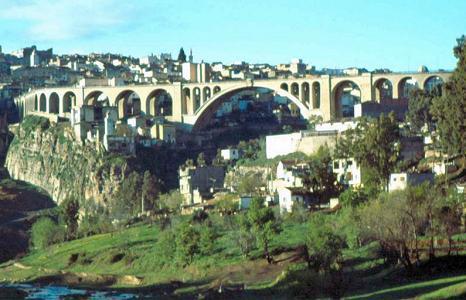
(Above: A city view of Constantine)
Despite these vivid memories, the story of the Constantine Jewry and the Algerian community in general, one of the largest Sephardic communities, is widely unfamiliar. Growing up in Israel, being of an Algerian ancestry was somewhat exotic. In a country that thrives on stereotypes of different Jewish ethnic groups, there are no jokes about Algerian Jews, simply because they are not widely represented in society. Given various reasons, primarily the weak Zionist infrastructure in Algeria during the first half of the twentieth century and the strong Francophile sentiments, most of Algerian Jews live in France. My family first immigrated to France and then to Israel the 1970’s. A smaller percentage immigrated to French Canada and to the United States and finally Israel.
But even in France, where most of them reside, Algerian Jews go practically unnoticed and often confused with their regional neighbors, Tunisian or Moroccan Jews. Benjamin Stora, a leading historian in France and a native of Constantine, refers to this phenomenon in his semi family memoire-semi historical book, Les Trois Exils. Juifs d'Algérie- The Three Exiles of Algerian Jewry (from French H.M.):
“The image of Sephardi Jews in France is normally associated with the Tunisian Jews in the movie "Truthfully, I am not lying” marching on the shores of Deauville or bustling around the Santier quarter. These are clichés, of course, but they fit the image of (Jewish) people from Tunisia or Morocco ... But where, are the Jews of Algeria? Their "invisibility" in the French society is striking. It is only at time of death that we learn that a certain personality was born there, as it was recently the case with (philosopher) Jacques Derida” (Stora, 9).
Stora argues that the “invisibility” and in some cases the hiding of the Algerian past of well-known figures (including, Nobel price winners, Olympic champions, authors, philosophes, film producers and fashion designers) stems from deep assimilation of Algerian Jews in French society. In fact, it seems that most Algerian Jews, including members of my family, identify themselves simply as French Jews. In order to explain this phenomenon, Stora unfolds his historical thesis, titled like his book, the three exiles or the three major shifts, which gradually pushed Algerian Jews to blend in French culture.
The First Exile, the depart from Jewish tradition, happened in 1871 (approximately 40 years after Algeria was annexed to France) when Algerian Jews were granted French citizenship. The collective naturalization, also known as the Crémieux Decree, opened the door for Algerian Jews to integrate in the French society, and as a result drastically changed the face of the community. Eagerly, Jews fostered French as their main language instead of Judeo-Arabic and Ladino, enrolled their children in French public school, acquired jobs in the French colonial administration, joined the French army, and participated in the national and municipal elections. The exposure to western ideas and way of life gradually diminished the supremacy of traditional rabbinical authorities. The secularization was encouraged by the French state, which imported “modern” rabbis from mainland France to Algeria, and enforced a pledge of allegiance to France in religious institutes. Within this framework, Constantine was the exception. The city, which was known in the pre-French era as “Little Jerusalem” because of its many Talmudic scholars, remained rather respectful to Jewish tradition. Yet, Constantine was not entirely exempted from the general trends, and according local records, eating shellfish post prayer time with the rabbi was a not a rare sight.

(Above: A photo from a French public school in Constantine. My mother’s cousin, Annie, is in the first row, first on the right).
While the mass naturalization presented Jews with great opportunities, it also sparked strong anti-Semitic sentiments among the European settlers in Algeria, who called for the abrogation of Cremièux Decree. The animosity against the Jews was nourished from Old Catholic anti-Jewish myths and later fueled by the racial ideologies spread in Europe in the first half of the twentieth century. Under this uncomfortable climate, Jews did their best to prove their absolute devotion to France and its ideals. However, they were not successful, as in some cases, the colonial propaganda, spurred hostility between Jews and Muslims. The pogrom in Constantine (August 3-5, 1934) was the most infamous example for that. During three days 23 Jews were murdered by their Muslim neighbors as French law enforcement officers did nothing to stop the violence. In age 93, my grandma still recalls the state of fear while hiding from the Muslim rioters.
The bloodshed in Constantine was a sad prelude to the Second Exile: the bitter rejection from the Patrie or the denial of their French nationality under the sovereign of the pro-Nazi collaborationist Vichy regime during World War II. In 1940, Marshal Philippe Pétain, the former World War I hero, who was appointed by the Germans to rule the southern part of France and its colonies overseas, pleased both the Germans and the racist settlers by immediately abolishing the Crémieux Decree, and promulgating a set of anti-Jewish laws, aiming to remove the Jews from positions of power. One of the most traumatic measures was the banishment of Jewish students from the French public schools and universities. My Grandma was one of those students summoned to the principle’s office. When asked if she was Jewish, she proudly shares how instead of feeling ashamed, she lifted her head up and replied “yes”.

(Above: My grandma in Constantine)

(Above: My grandma in constantine, in the second row, wearing a white outfit)
Beyond the legal restrictions, the loss of their French citizenship was mentally painful. Algerian Jews could not grasp how their beloved France, which they served loyally, turned its back to them. One of the responses to the circumstances was the foundation of the French resistance group, which consisted mostly of Jewish members. Fearing a direct German intervention, many young Jews chose to take an active stance and clandestinely assist the Allies’ attempt to establish a new front in North Africa by landing on the shores of Algeria. On November 8, 1942, after months of preparations, the resistance staged a Coup-d'etat, and took over the capital Algiers by neutralizing the police headquarter, several army camps and the local radio station. The successful execution of their plan, assured the smooth landing of the Allies, and in the longer run paved the way for the Allies’ victory in the North African campaign in World War II. Israeli researcher, Gita Amipaz Silber, who studied the resistance closely, argued the members were motivated by their “Jewish pride”. Nonetheless, testimonials of former members, backed by other academic works, show that they operated as French patriots striving to bring France back to its original pre-Vichy values.
The restoration of their civil rights and the fall of the Vichy regime did not end the tragic chapter in the history of Algerian Jews. The postwar era and particularly the emergence of the Algerian National Movement, created an uncomfortable environment for the Algerian Jewry. The hierarchy between Jews and Muslims created by French colonialism, forever tarnished the relationship and created a rupture that is still present in France today (as demonstrated in Maud Mandel’s excellent book, Muslims and Jews in France: History of a Conflict). Therefore, the Third Exile was the physical exodus of Algerian Jews from their native birthplace to their aspired homeland, France. Indeed, the immigration experience was relativity easy as many Jews were able to retain their old positions in French administration (as did my grandfather), and there were no language barriers. Yet, many emigrants kept longing for their original home across the Mediterranean.
Perhaps the one, who captures best this spirit of yarning, is Singer Enrico Macias, an old neighbor of my Grandma in Constantine (so she claims). Macias’ lyrics discuss both the experience of immigration, the actual boarding on the boat and the looking back at the white rocks; alongside the amazement with the new land, and primarily its elegant capital, Paris. In addition, Macias is a virtuoso guitar player, and his melodies inspired by Andalusian and Arabic music traditions, add a beautiful oriental twist to his French singing. One of my favorite songs, Non je n'ai pas oublié- No, I haven’t forgotten (click the hyperlink for English lyrics and video) is an example of the tension between past and present. He is much admired the general French public and he has a special place in the French hall of fame next to Edith Piaf and Charles Aznavour.
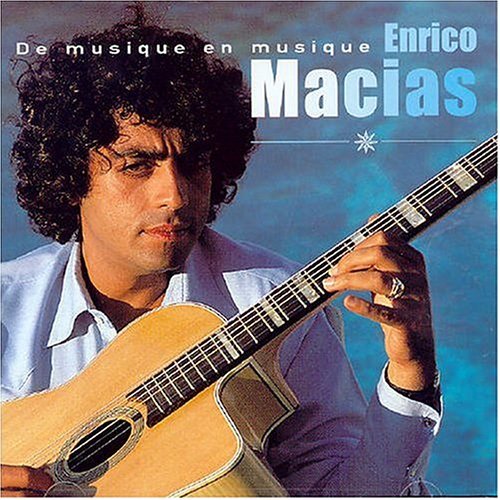
(Above: Enrico Macias)
Music is not the only reminder for Algerian Jews about their origin. Food also plays an important role in maintaining cultural distinction. Within my grandma’s French bubble in Israel, which included frequently serving endives salad, baguette avec beurre, Camembert cheese and apple tart (not to mention that TV-5 was almost always in the background), there was a special place for traditional dishes. Being located on the southern- western shores of the Mediterranean, the Jewish Algerian Cuisine is heavily influenced by the aromas of the Iberian Peninsula. The repopulation of the North African communities with Spanish and Portuguese refugees after the Spanish expulsion (beginning in the late 15th century) definitely added to this strong Iberian thread, which includes dishes, such as Merguez sausage, sautéed spinach with garbanzo beans, ground beef triangle pastels and fried fish. There are also classic North African dishes, such as Macbooba (burnt vegetable salad), honey dipped dough cigars, Mafroom (potato stuffed with ground beef) and, of course, Couscous (recipe ahead). Thus, in a nutshell, Algerian cuisine can be defined as Sephardic-Mediterranean kitchen with North African accents and a French touch.
And now for the Couscous. Algerian Jews are very particular about their couscous. They will never eat it in a restaurant, or out of the box, and refuse to even taste couscous made by Jews from other North African communities (i.e. Tunisian, Moroccan and Libyan Jews). Their couscous (and I am just echoing everything I heard growing up) is superb because its refined texture resembling tiny sand grains, its minimal seasoning (other than Merguez, Algerian cuisine is not spicy) and its perfectly cooked vegetables (not too mushy- not too hard). In other words, or as they put it themselves, it’s the French version of couscous! It is truly incredible how one dish can encapsulate so much attitude!
In their defense, the making of Algerian style couscous, the way my grandma and my mom cook it, is very laborious. In the few times, I made it myself I used shortcuts, such as substituting a food processor for manually sifting the grains over and over again. In addition to the rewarding nature of the process, the final result is very delicious and hearty. During Friday night dinners at my grandma house, everybody was waiting for this one dish, this white mountain decorated with colorful vegetables in an unassuming glass bowl. Despite the abundance of foods on the table, my grandma and my mother always had to go back to the kitchen to refill the bowl. These days I am glad to witness my young son devouring a plateful of my favorite semolina nosh.
Before finally handing the recipe, a couple of helpful notes:
A. Couscous is a seasonal dish. The cold winter months are ideal for filling your stomach with it.
B. Toppings may change. In my household, we served it with garbanzo beans, turnips, zucchinis and carrots. Hard boiled eggs are also a great addition. Some people like eating couscous with a zesty salad (shredded carrots in lemon) or raw vegetables (radishes) on the side.
C. Sauce is traditionally meat based. However, couscous is veggie friendly, and the sauce is delicious also in its vegetarian version.
D. Clear some time. This is not a quick recipe and even with shortcuts, the process of steaming and sifting the grains several times, is quite long even for experienced cooks.
E. The cooking of Couscous requires a special pot called a couscoussier, a traditional double-chambered steamer. For those who don’t have it, a pasta pot with a steamer or just placing a steamer or a colander on a regular pot should work as well.

(Above: My mother making couscous)
My Family Recipe for Couscous
Couscous Grains
Ingredients:
2.2 Ib. (1 kg) semolina (thick grain)
(About) 5 cups water
5 tbs. oil
1 tbs. salt
Directions:
-Fill a large pot with water and bring to a boil.
-Place semolina grains in a big fine mash strainer on top of a large bowl. Pour water over the grains (1 ½-2 cups) and knead the grains, so they will absorb the water. Then sift them through the strainer. Try as much as possible to avoid little balls. Use food processer if you are having difficulty in creating this fine texture.
-Put the grains in the steaming basket on top of the boiling water in the couscoussier (or your alternative pot), cover and cook on medium heat for 30 minutes.
-Remove from heat and place the grains in the strainer again on top of the bowl.
-Once you are done sifting, pour additional 3 cups of water, oil and salt.
-Mix the grains in the bowl and use hands to create tiny little grains.
-Put the grains back in the steaming basket and steam for additional 30 minutes.
-Pour the grains in in a bowl and let cool.
(Repeat the sifting and steaming process for a third time if the grains are too coarse).
Couscous Sauce
Ingredients:
3 cups of garbanzo beans soaked overnight
4 zucchini peeled and cut halfway through
4 carrots peeled and cut halfway through
3 small turnips quartered
2 lbs. meat – beef or lamb (optional)
3 bay leaves
Salt and Pepper
Directions:
-Layer ingredients in a big pot in the following order: garbanzo beans, meat, bay leaves and vegetables.
- Cover with water and bring to a boil on high heat.
- After 40 minutes reduce heat to simmer, add salt and pepper and cook for another 2 ½ to 3 hours until vegetables, meat and beans are soft but not too mushy. Remove bay leaves.

(Above: The different stages of the process)
For serving:
Place couscous grains in a bowl. Arrange vegetables, meat and beans on top and add one or two scoops of the sauce. Basically just to moisten the grains a little bit. Pour the rest of the sauce in a separate sauce for extras.
Bon Appetit!
0 notes
Text
Aleppo: The Crown Jewel of the Jewish Levant
Aleppo. Tragic images of wounded children and bombed houses come to mind. After over 6 years of a brutal Syrian civil war, it is hard to imagine that decades ago Aleppo was a major commercial hub with a glorious past dating to the third millennium BC. It is ever harder to believe that among its ancient streets once lived a flourishing Jewish community known for its savvy merchants, Jewish scholarship and distinct culinary tradition ( the Ful Medammas recipe below is one example). Perhaps now while we are overwhelmed with images of Aleppo’s destruction, it is an appropriate time to look back and explore its fascinating Jewish heritage.

(Above: The ancient Citadel in Aleppo)
Aleppian Jewry has been a little obsession of mine for some time now. I read avidly about this topic and am guilty of excessive use of Aleppo pepper. Yes, I am quite the history nerd, but I truly think, there is something so captivating about Jews in Aleppo. What sparked my curiosity was learning that Aleppian Jews, who fled Syria in time of distress, were able to resettle in cities around the world, revive their rich heritage, and become productive or even prominent members in their adopted land. This is particularly true of Aleppian Jews residing in Latin America. On a trip to Panama City, my husband and I dined at one of the kosher staple restaurants, Darna during Friday lunchtime. Dressed in our weary travelers clothes, we found ourselves surrounded with well-to-do men with yarmulkes and posh ladies with perfect manicures and Chanel purses. Later, we learned that this is a common scene in the life of the wealthy Aleppian community in Panama.
This all makes me wonder, what is the secret of the Aleppian Jewry? How are they able to remain so successful and powerful even after the collapse of their original home community? And how do they manage to maintain their community strong and consolidated in a world embracing cultural exchanges? Potential answers to these questions lay in the long history of the community.
So, when does it start? According to Jewish tradition (documented in Psalm 60 and Sefer HaYashar 22:39), Aram, the son of Abraham’s half-brother Tzoba was the first to settle in what is now Aleppo. Due to this belief, Jewish writings almost always refer to Aleppo as Aram Tzoba ארם צובא. According to another local legend based on biblical sources, the first Jewish pioneers arrived in the 9th century BCE when King David’s army conquered the city. Nevertheless, historical records indicate that Jewish presence began only in the 6th century BCE, and grew substantially after the destruction of the Second Temple in 69 CE. The native Jews in the city were named Must’arabim, meaning resembling the Arabs.

(Above: The Old Synagogue)
Over the centuries, the Aleppian community experienced numerous transitions of power between empires, including a Roman rule, a Muslim conquest and a traumatic Mongol invasion. But, even under the constant regional turbulence, the Jewish community remained committed to high standard of Jewish learning. Aleppo’s lore, which was praised by Maimonides, attracted rabbinical scholars from all around the medieval world. Given its importance as a Jewish center, in the 14th CE, the Aleppian community was granted with the sacred task of guarding a rare bible manuscript, Keter Aram Tzoba כתר ארם צובא the Crown of Aram Tzoba, or The Aleppo Codex. The community fervently guarded the codex for 600 hundreds years in a designated structure. The state of Israel is currently the guardian of the Aleppo codex, although Aleppian Jews insist that the manuscript legally and historically belongs to them.

(Above: Pages from the Aleppo Codex)
The arrival of Sephardic Jews, the fugitives of the Spanish inquisition, in the second half of the 16th century was an important in terms of community development. Loyal to their own liturgy and rituals, the Sephardim, collectively known in Aleppo as Francos, formed their own synagogue and community institutions and married among themselves. However, as time progressed, the boundaries between the Must’arabim and the Francos gradually dissolved through marital bonds and cultural integration. That same period of time is also associated with the great economic expansion of Aleppo during the Golden Era of the Ottoman Empire. Located in the heart of the empire, Aleppo was a crossroads between east and west. Using their connections with their Jewish brethren in other ports cities around the empire and their language skills, Aleppian Jews prospered trading Persian silk, Indian spices and many other exquisite goods.

(Above: The Jewish Expulsion from Spain)
With the decline of the Ottoman Empire in the 19th century Aleppo temporarily lost its luster and begun to play a less critical role in international trade. Aleppian Jews were forced to adapt to the new reality. Some initially remained in Aleppo, but the majority ended up migrating to pursue wealth in other cities in the Middle East (mainly Beirut and Cairo) and in the Americas, such as Mexico City, Panama City, Buenos Aires and Sao Paulo. The largest branch, however, was formed in Brooklyn, New York. In the new cities, the Aleppian community zealously preserved their unique cultural and religious piety and established their own community institutions to distinguish themselves from the local Ashkenazi community. In the same spirit, the ties between the new centers remained tight as Aleppian Jews keep strong business and family relations with their relatives overseas.
The Aleppo born author, Amnon Shamush, who was also one of the founders of kibbutz Ma’ayan Baruch in Israel wrote extensively about the phenomenon of the cross-national alliance connecting the Aleppain communities. In his well-know novel about the archetypical Aleppian family, Michel Ezra Safra and His Sons (מישל עזרא ספרא ובניו), he writes (translation from Hebrew - H.M.) about marriages:
“As the Aleppian diaspora moved further from its original center, the need for matchmakers with steady connections in the various countries grew. An Aleppian with a daughter, who reached the age of matrimony, will not rest until he will find her a suitable Aleppian fellow from a good family. And if he cannot find her such a guy in his own country, he will find it in a different country, because in any place there is commerce in the world, one can find an Aleppian or two” (Shamush, 23).

(Above: Jewish wedding in Aleppo, 1914)
In regards to business ties, Shamush sheds light about the culture of nepotism:
“If we check what are the secrets of the success of Michel and his sons, we will discover their many tricks. But first the foremost, they do not rely on strangers. Not only the heads of their branches are family, but also many of their employees are relatives, and if not actual family members, at least people from our town (Aleppo- H.M.), from good reliable families” (Ibid, 16).

(The Ades Family, 1933)
While conducting business or celebrating a Bar Mitzvah or a wedding, Aleppian Jews relish on delicacies from their superb cuisine, which is as much of a source of pride as the community’s fortune. The Jewish Aleppian gastronomy was developed throughout the centuries, influenced by the local Arabic cooking (exemplified by the use of grains, such as rice and bulgur) refined by new flavors brought by the Sephardim (particularly cooking with olive oil) and enriched by the bounty of produce and spices introduced by the vast commerce (turmeric and cumin, for example). The plethora of recipes passed verbally from mother to daughter was masterfully combined into the book, The Aromas of Aleppo: The Legendary Cuisine of Syrian Jews by Poopa Dweck, an Aleppian residing in New Jersey. This is not just an ordinary cookbook; it’s an absolutely beautiful collection weaving together recipes with a historical overview (heavily used for this blog), family anecdotes and authentic footage. The book was highly praised by distinguished chefs, and rumor says that the ruthless Bashar Al Assad, purchased several copies.

(Above: A fan of Jewish Aleppian cooking: Basahr Al Asad)
Anyhow, in the book Dweck emphasizes that in the Aleppian household culinary traditions are highly revered. The Shabbat table begins with a colorful tapestry of mezze (small dishes) plates, dessert is in most cases composed from fruit and nuts (because, Dweck, explains, in the end of the meal there is no room for pastries), and holiday festivities are greatly anticipated due to the special dishes in store. Aleppian women, Dweck continues, earn advanced degrees and run a modern lifestyle, however, they are ultimately evaluated by their level of Suffeh, an Arabic word, which literally means “orderliness” but vastly refer to a woman’s ability to maintain a perfect household, and perform as the divine hostess offering her guests delicious treats while keeping an impeccable home and personal appearance.

(Above: Poopa Dweck)
Although I am not of Aleppian decent, the Sephardic in me keep me striving for Suffeh and trying my luck with various Aleppian dishes. While the Aleppo cuisine prides itself on numerous unique recipes, I was excited to discover in Dweck’s book several familiar Sephardic staples, such as stuffing almost every vegetable with rice and ground beef and frequently using semolina and almond paste for sweets. For the purpose of this blog, I chose a classic Aleppian recipe, popular on the Sunday morning table and a regular in the post Yom-Kippur meal: Ful Medammas – Warm Fava Beans.
A couple of helpful comments regarding preparation:
(a) I couldn’t find dried fava beans at my nearby grocer. Therefore, I bought the canned fava beans I found in the Middle Eastern section. Using canned beans will save you the time of overnight soaking them and cooking them, and they seemed to work just fine. If you are trying to perfect the recipe and don’t have a time crunch, soaking and cooking would be worthwhile.
(b) The recipe is quick and simple to make, however, it requires a chopped bunch of parsley, which is the most laborious step, if you (like me) diligently separate the leaves from stems and pat them dry with paper towels.
(c) I love the lemony taste of this mezze, so I added another lemon to the original recipe (3 lemons total)

(Above: the preparation)
And here it is: Ful Medammas – Warm Fava Beans by Poopa Dweck Ingredients:
2 cups dried fava beans soaked overnight (or two 16-ounce cans) 3 tablespoons olive oil Freshly squeezed lemon juice from 1 or 2 lemons 1 teaspoon ground cumin
1⁄4 teaspoon Aleppo pepper (or crushed red pepper) 1⁄2 teaspoon kosher salt
1 bunch of flat-leaf parsley chopped 2 hard-boiled eggs chopped
- Cook beans in medium saucepan, covering them with ample amount of water. Bring to a boil over high heat, then reduce to medium heat and simmer for 1 hour. Make sure beans are soft but not mushy. Then carefully drain. If using canned beans, cook in medium heat for several minutes to warm the beans. No water needed. Transfer beans to a bowl.
- Combine olive oil, lemon juice, cumin, Aleppo pepper, salt and parsley. Pour over the beans and toss. Garnish with eggs.

(Above: The delicious final result)
Enjoy!
2 notes
·
View notes
Text
Aleppo: The Crown Jewel of the Jewish Levant
Aleppo. Tragic images of wounded children and bombed houses come to mind. After over 6 years of a brutal Syrian civil war, it is hard to imagine that decades ago Aleppo was major commercial hub with a glorious past dating to third millennium BC. It is ever harder to believe that among its ancient streets, lived once a flourishing Jewish community known for its savvy merchants, Jewish scholarship and distinct culinary tradition (stay tuned for a recipe ahead). Perhaps now while we sadly watch photos of Aleppo’s current state of destruction, is a good time to look back and explore its fascinating Jewish heritage.

(Above: The ancient Citadel in Aleppo)
Aleppian Jewry is for a while now a little obsession of mine. If I meet a descendant of the community, I’m immediately intrigued and seek a conversation about family roots. I read avidly about this topic, and in my kitchen my fasciation is manifested itself to an excessive use of Aleppo pepper. Yes, I am quite the history nerd, but I truly think, there is something incredibly captivating about Jews in Aleppo. What possibly sparked my curiosity was learning that Aleppian Jews, who fled Syria in time of distress, were able to settle in new centers around the world, revive their rich heritage, and conquer positions of power within the public realm in their new home countries. This is particularly true about Aleppian Jews residing in Latin America, where Aleppian Jews play a key role in the countries’ finance system and politics. Several years ago in a trip to Panama City I witness this phenomenon firsthand. My husband and I stepped upon one of the kosher staple restaurants in the city, Darna, during Friday lunchtime. Embarrassingly dressed in our weary travelers clothes, we found ourselves surrounded with well to do men with yarmulkes and posh ladies with perfect manicures and Chanel purses. Later, we learned that this is a common scene in the life of the wealthy Aleppian community in Panama.
This all makes me wonder, what is the secret of the Aleppian Jewry? How are they able to remain so successful and powerful even after the collapse of their original home community? And how do they manage to maintain their community strong and consolidated in a world embracing cultural exchanges? Potential answers to these questions lay in the long history of the community.
So, when does it start? Well, along long time ago. According to Jewish tradition (documented in Psalm 60 and Sefer HaYashar 22:39), Aram, the son of Abraham’s half-brother Tzoba was the first to settled in nowadays Aleppo. Due to this belief, Jewish writings almost always name Aleppo as Aram Tzoba צובא ארם. According to another local legend based on biblical sources, the first Jewish pioneers arrived in the 9th BCE when King David’s army conquered the city. Nevertheless, historical records suggest that Jewish presence began only in the 6th century BCE, and grew substantially after the destruction of the Second Temple in 69 CE. The native Jews in the city were named Must’arabim, meaning resembling the Arabs.

(Above: The Old Synagogue)
Over the centuries, the Aleppian community experienced numerous transition of power between empires, including a Roman rule, a Muslim conquest and a traumatic Mongol invasion. But, even under the constant regional turbulence, the Jewish community remained committed to high standard of Jewish learning. Aleppo’s lore, which was praised by Maimonides, attracted rabbinical scholars from all around the medieval world. Given its importance as Jewish center, in the 14th CE, the Aleppian community was granted with the sacred task of guarding a rare manuscript of bible, now known as Keter Aram Tzoba (צובא ארם כתר) the Crown of Aram Tzoba, or The Aleppo Codex. The community fervently guarded the codex for 600 hundreds years in a designated structure. The state of Israel is currently the guardian of the Aleppo codex, although Aleppian Jews insist that the manuscript legally and historically is the community possession.

(Above: Pages from the Aleppo Codex)
The arrival of Sephardic Jews, the fugitives of the Spanish inquisition, in second half of the 16th century was an important landmark in community chronicles. Loyal to their own liturgy and rituals, the Sephardim, collectively known in Aleppo as Francos, formed their own synagogue and community institutions and married among themselves. However, as time progressed, the boundaries between the Must’arabim and the Francos gradually dissolved through marital bonds and cultural integration. That same period of time is also associated with the great economic expansion of Aleppo during the Golden Era of the Othman Empire. Pivotally located in the heart of the empire, Aleppo served as focal point in the trade between east to west. Using their connections with their Jewish brethren in other ports cities around the empire and their language skills, Aleppian Jews prevailed this prosperous commerce trading Persian silk, Indian spices and many other exquisite goods.

(Above: The Jewish Expulsion from Spain)
With the decline of the Ottoman Empire in the 19th century Aleppo lost its luster and now played a marginal role in the new world’s trading. Nonetheless, relaying on their well-established networks, Aleppian Jews adapted to the new reality. Some initially remained in Aleppo, but the majority ended up migrating to pursue wealth in other cities in the Middle East (mainly Beirut and Cairo) and in the Americas, such as Mexico City, Panama City, Buenos Aires and Sao Paulo. The largest branch, however, was formed in Brooklyn, New York. In the new centers, the Aleppian community zealously preserved their unique cultural and religious piety and established their own community institutions to distinguish themselves from the local Ashkenazi community. In the same spirit, the ties between the new centers remained tight as Aleppian Jews keep strong business and family relations with their relatives overseas.
The Aleppo born author, Amnon Shamush, who was also one of the founder of kibbutz Ma’ayan Baruch in Israel, wrote extensively about the phenomenon of the cross-national alliance connecting the Aleppain communities. In his well-know novel about the archetypical Aleppian family, Michel Ezra Safra and His Sons (ובניו ספרא עזרא מישל), he writes (translation from Hebrew - H.M.) about marriages:
“As the Aleppian diaspora moved further from its original center, the need for matchmakers with steady connections in the various countries grew. An Aleppian with a daughter, who reached the age of matrimony, will not rest until he will find her an suitable Aleppian fellow from a good family. And if he cannot find her such a guy in his own country, he will find it in a different country, because in any place there is commerce in the world, one can find an Aleppian or two” (Shamush, 23).

(Above: Jewish wedding in Aleppo, 1914)
In regards to business ties, Shamush sheds light about the culture of nepotism:
“If we check what are the secrets of the success of Michel and his sons, we will discover their many tricks. But first the foremost, they do not relay on strangers. Not only the heads of their branches are family, but also many of their employees are relatives, and if not actual family members, at least people from our town (Aleppo- H.M.), from good reliable families” (Ibid, 16).

(The Ades Family, 1933)
While conducting business or celebrating a Bar Mitzvah or a wedding, Aleppian Jews relish on delicacies from their superb cuisine, which is as much of a source of pride as the community’s fortune. The Jewish Aleppian gastronomy was developed throughout the centuries, influenced by the local Arabic cooking (exemplified by the use of grains, such as rice and bulgur) refined by new flavors brought by the Sephardim (particularly cooking with olive oil) and enriched by the bounty of produce and spices introduced by the vast commerce (turmeric and cumin, for example). The plethora of recipes passed verbally from mother to daughter was masterfully combined into the book, The Aromas of Aleppo: The Legendary Cuisine of Syrian Jews by Poopa Dweck, an Aleppian residing in New Jersey. This is not just an ordinary cookbook; it’s an absolutely beautiful collection weaving together recipes with an historical overview (heavily used for this blog), family anecdotes and authentic footage. The book was highly praised by distinguished chefs, and rumor says that the ruthless Syrian dictator, Bashar Al Assad, purchased several copies. I wonder if he still enjoys cooking Aleppian recipes after demolishing the city and slaughtering its inhabitants.

(Above: A fan of Jewish Aleppian cooking: Basahr Al Asad)
Anyhow, in the book Dweck emphasizes that in the Aleppian household culinary traditions are highly revered. The Shabbat table begins with a colorful tapestry of mezze (small dishes) plates, dessert is in most cases composed from fruit and nuts (because, Dweck, explains, in the end of the meal there is no room for pastries), and holiday festivities are greatly anticipated due to the special dishes in stored. Aleppian women, Dweck continues, may earned advanced degrees and run a modern lifestyle, however, they are ultimately evaluated by their level of Suffeh, an Arabic word, which literally means “orderliness” but vastly refer to a woman’s ability to maintain a perfect household, and preform as the divine hostess offering her guests with delicious treats while keeping an impeccable home and personal appearance.

(Above: Poopa Dweck)
Although I am not of an Aleppian decent, I am attempting to be accredited with the honorable Suffeh and try my luck with various Aleppian dishes. Although the Aleppo kitchen definitely prides itself in numerous unique recipes, I was excited to discover in Dweck’s book several familiar Sephardic staples, such as stuffing almost every vegetable with rice and ground beef and frequently using semolina and almond paste for sweets. For the purpose of this blog, I chose a classic Aleppian recipe, popular on the Sunday morning table and a regular in the post Yom-Kippur meal: Ful Medammas – Warm Fava Beans.
A couple of helpful comments regarding preparation:
(a) I couldn’t find dried fava beans in my nearby grocer. Therefore, I bought canned fava beans in the Middle Eastern section. Using canned beans will save you the time of overnight soaking them and cooking them, and they worked just fine.
(b) The recipe is quick is simple to make, however, it requires a chopped bunch of parsley, which is time consuming, if you (like me) diligently separate the leaves from stems and pet them dry with paper towels.
(c) I love the lemony taste of this mezze, so I added another lemon to the original recipe (3 lemons total)
And here it is: Ful Medammas – Warm Fava Beans by Poopa Dweck
Ingredients:
2 cups dried fava beans soaked overnight (or two 16-ounce cans)
3 tablespoons olive oil
Freshly squeezed lemon juice from 1 or 2 lemons
1teaspoon ground cumin
¼ teaspoon Aleppo pepper (or crushed red pepper)
½ teaspoon kosher salt
1 bunch of flat-leaf parsley chopped
2 hard-boiled eggs chopped
1. Cook beans in medium saucepan, covering them with ample amount of water. Bring to a boil over high heat, then reduce to medium heat and simmer for 1 hour. Make sure beans are soft but not mushy. Then carefully drain. If using canned beans, cook in medium heat for several minutes to warm the beans. No water needed. Transfer beans to a bowl.
2. Combine olive oil, lemon juice, cumin, Aleppo peper, salt and parsley. Pour over the beans and toss. Garnish with eggs.
Enjoy!
8 notes
·
View notes